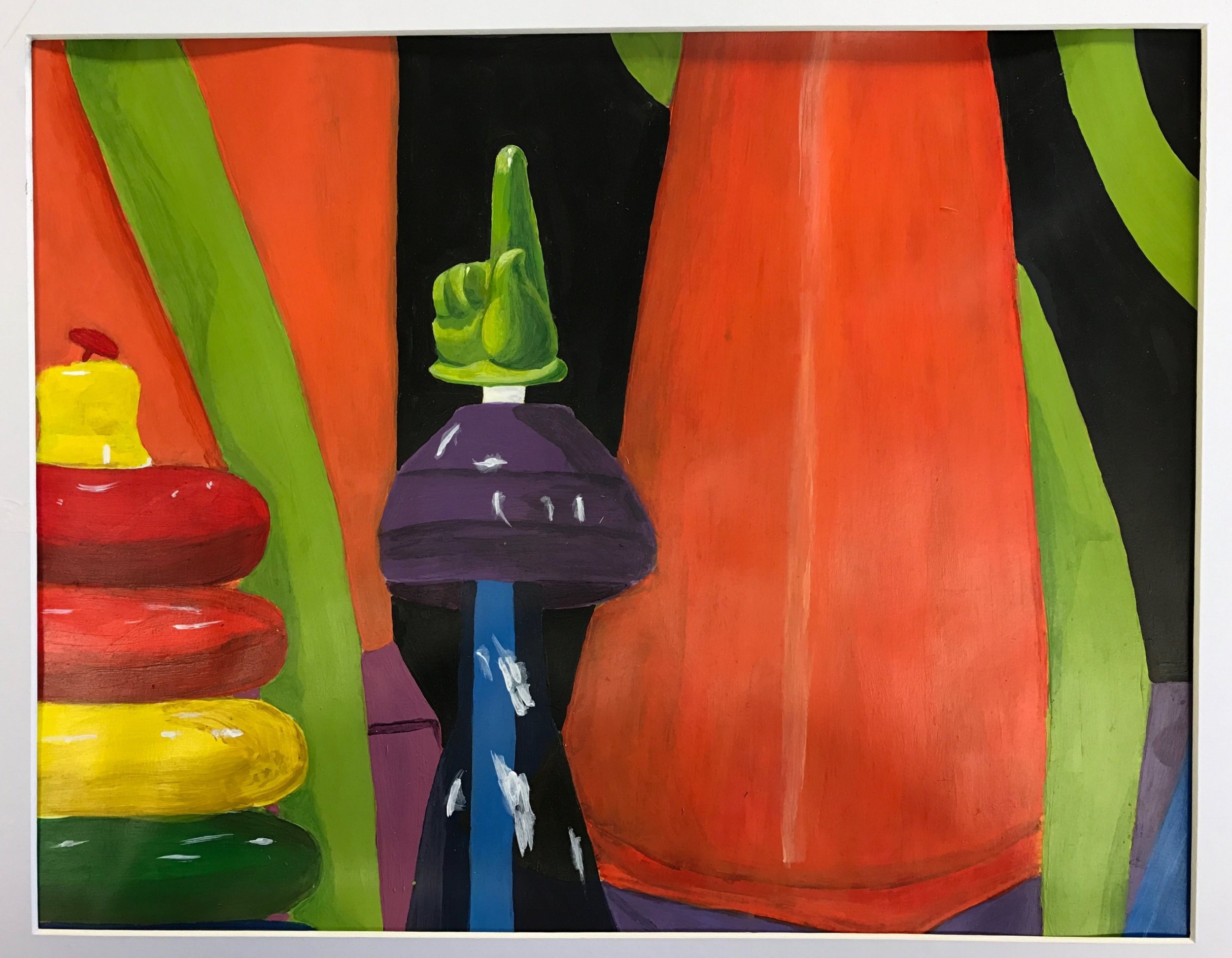
Secondary Student Teaching (SAIC)

Perspective and Proportion Still Life Paintings
High school Painting and Drawing students worked on capturing light and color using acrylic paint and a handmade viewfinder to measure proportion of a still life from their perspective.
Acrylic on bristol paper
9" x 12"
2017
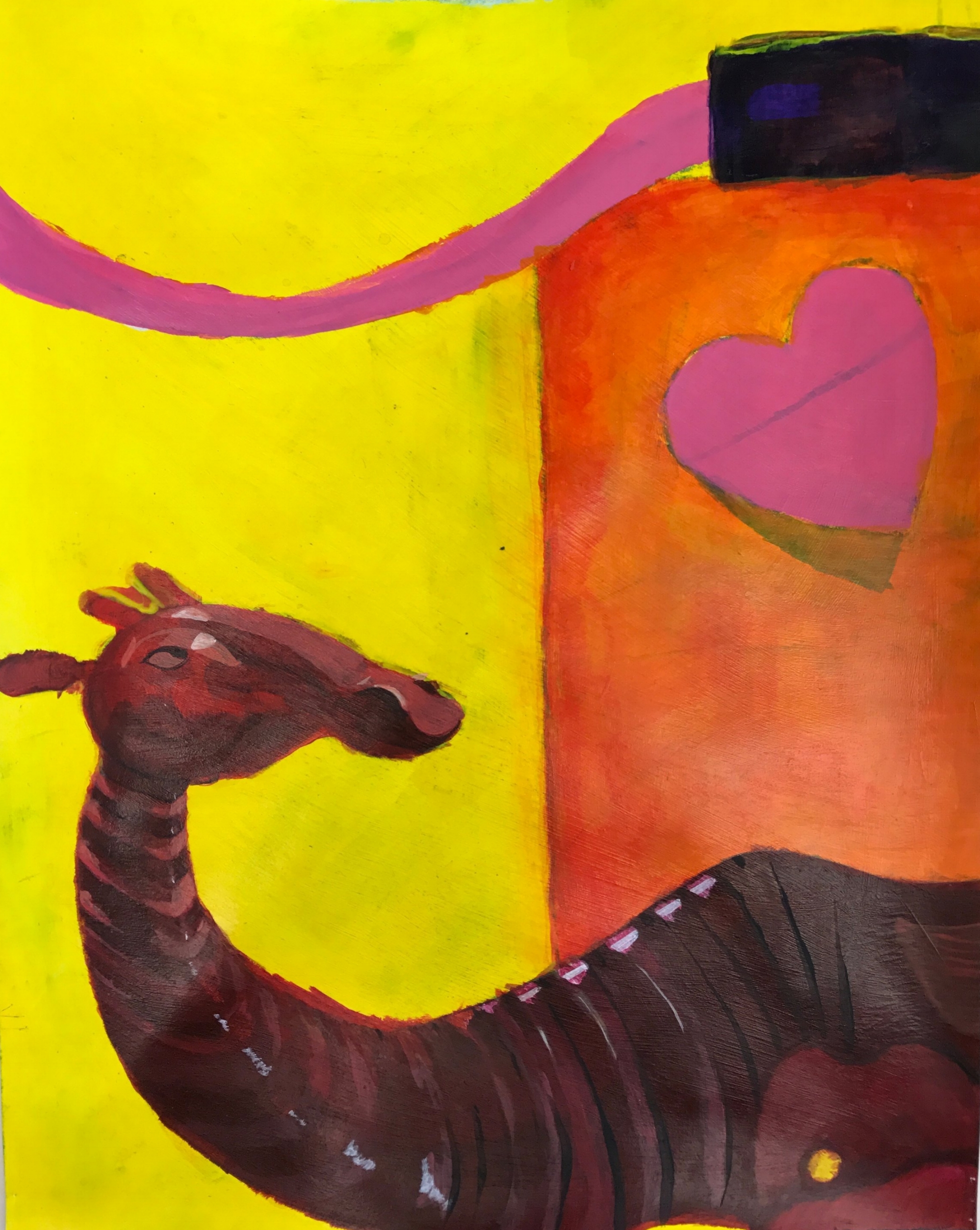
Perspective and Proportion Still Life Paintings
High school Painting and Drawing students worked on capturing light and color using acrylic paint and a handmade viewfinder to measure proportion of a still life from their perspective.
Acrylic on bristol paper
9" x 12"
2017

Perspective and Proportion Still Life Paintings
High school Painting and Drawing students worked on capturing light and color using acrylic paint and a handmade viewfinder to measure proportion of a still life from their perspective.
Acrylic on bristol paper
9" x 12"
2017
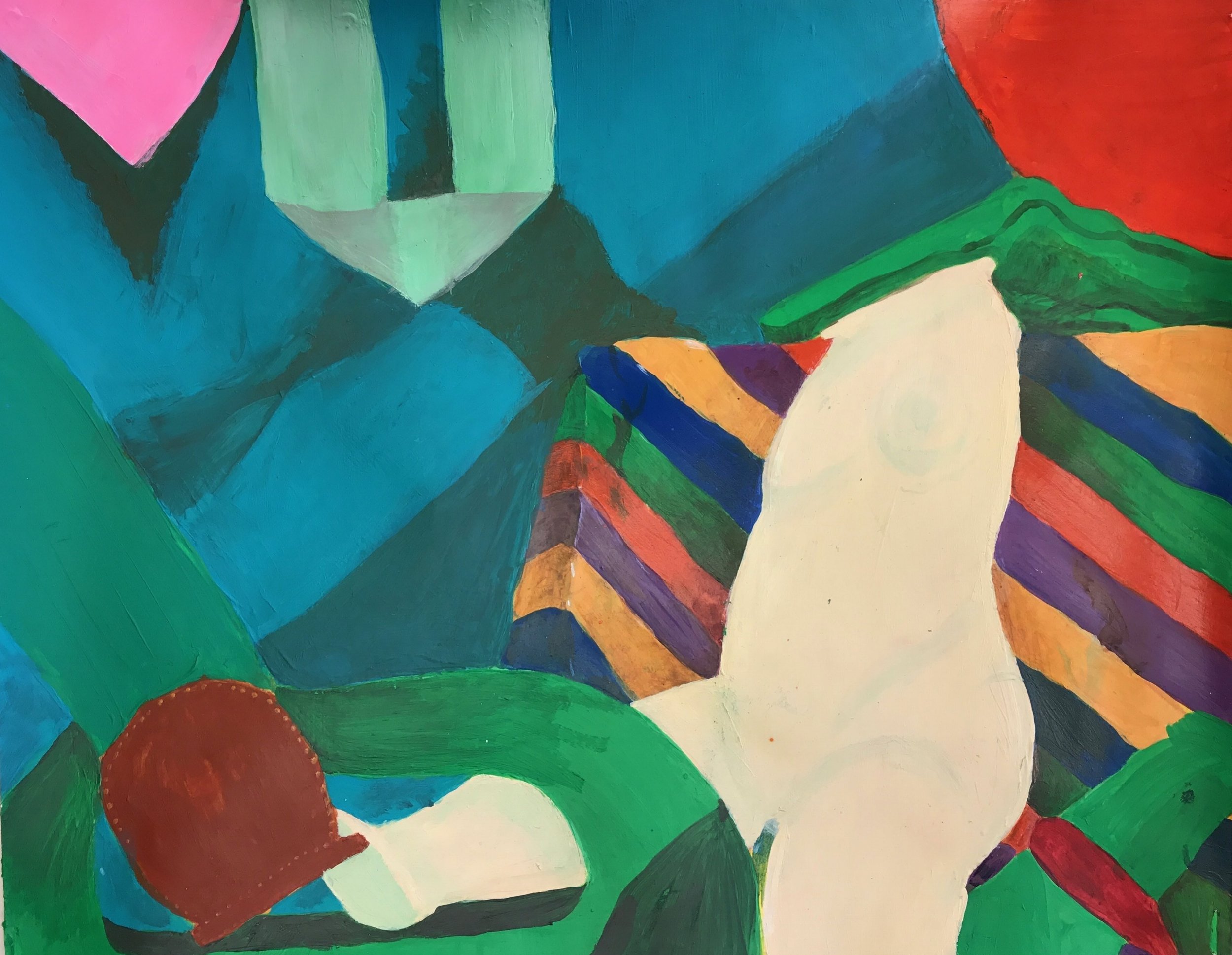
Perspective and Proportion Still Life Paintings
High school Painting and Drawing students worked on capturing light and color using acrylic paint and a handmade viewfinder to measure proportion of a still life from their perspective.
Acrylic on bristol paper
9" x 12"
2017
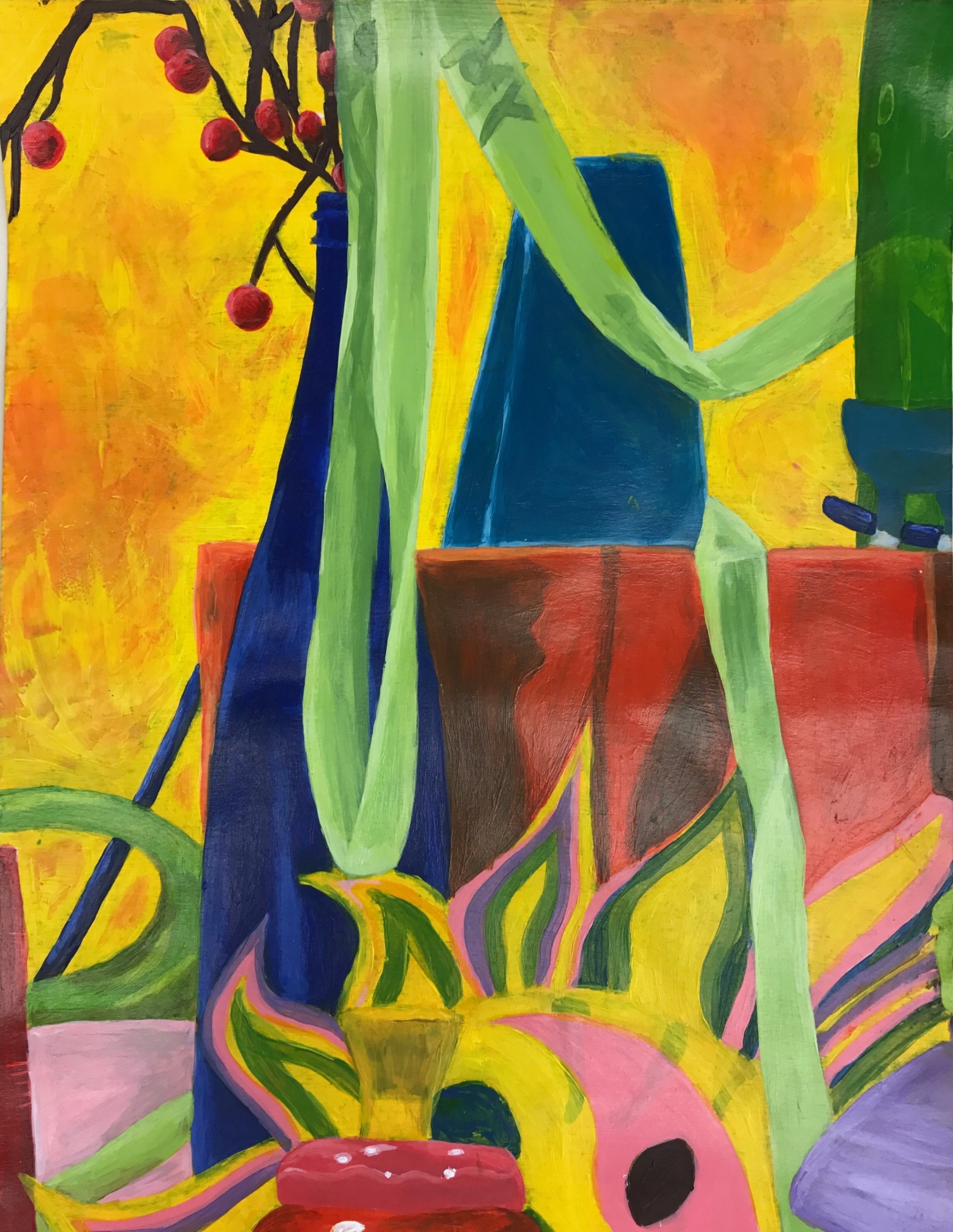
Perspective and Proportion Still Life Paintings
High school Painting and Drawing students worked on capturing light and color using acrylic paint and a handmade viewfinder to measure proportion of a still life from their perspective.
Acrylic on bristol paper
9" x 12"
2017
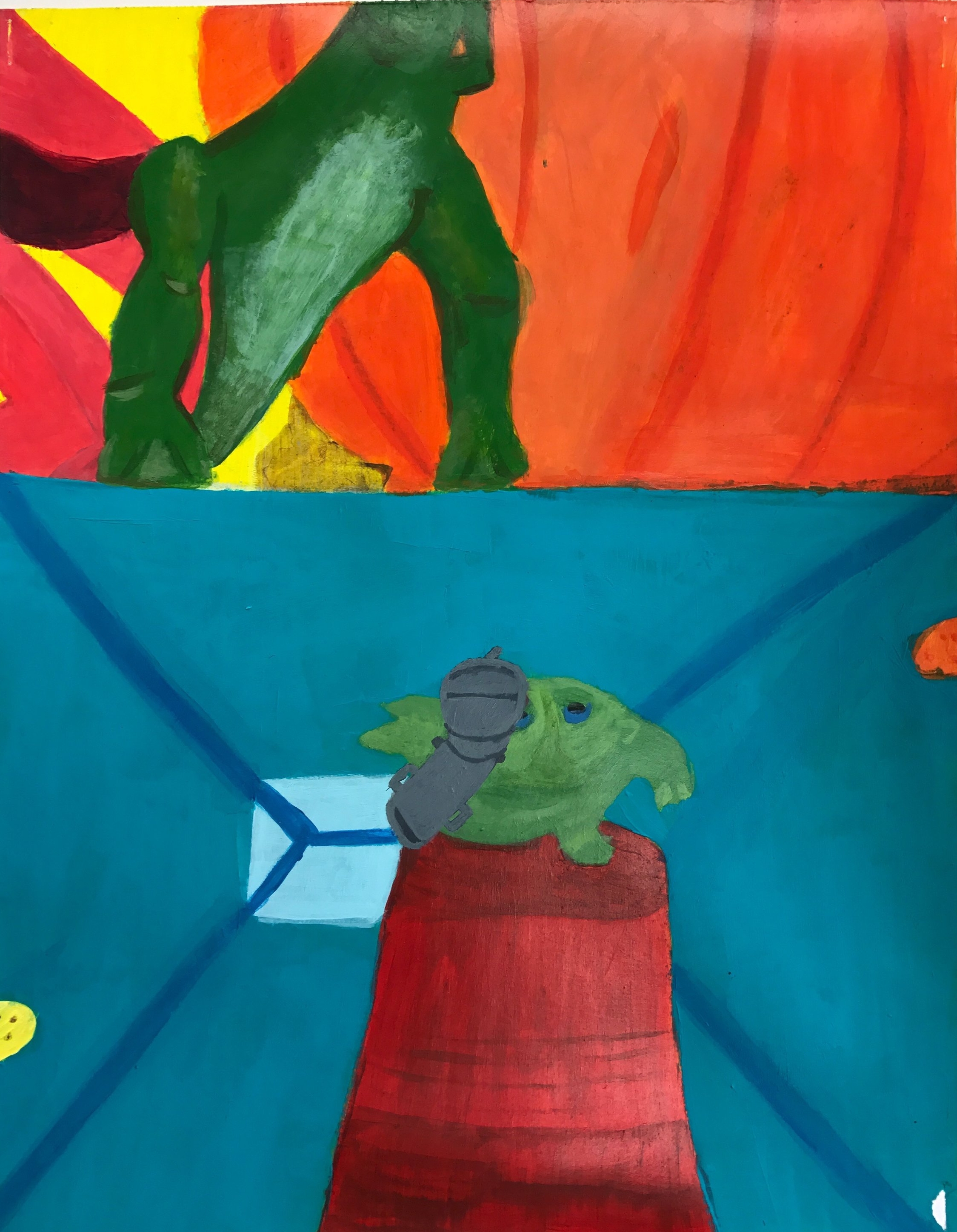
Perspective and Proportion Still Life Paintings
High school Painting and Drawing students worked on capturing light and color using acrylic paint and a handmade viewfinder to measure proportion of a still life from their perspective.
Acrylic on bristol paper
9" x 12"
2017
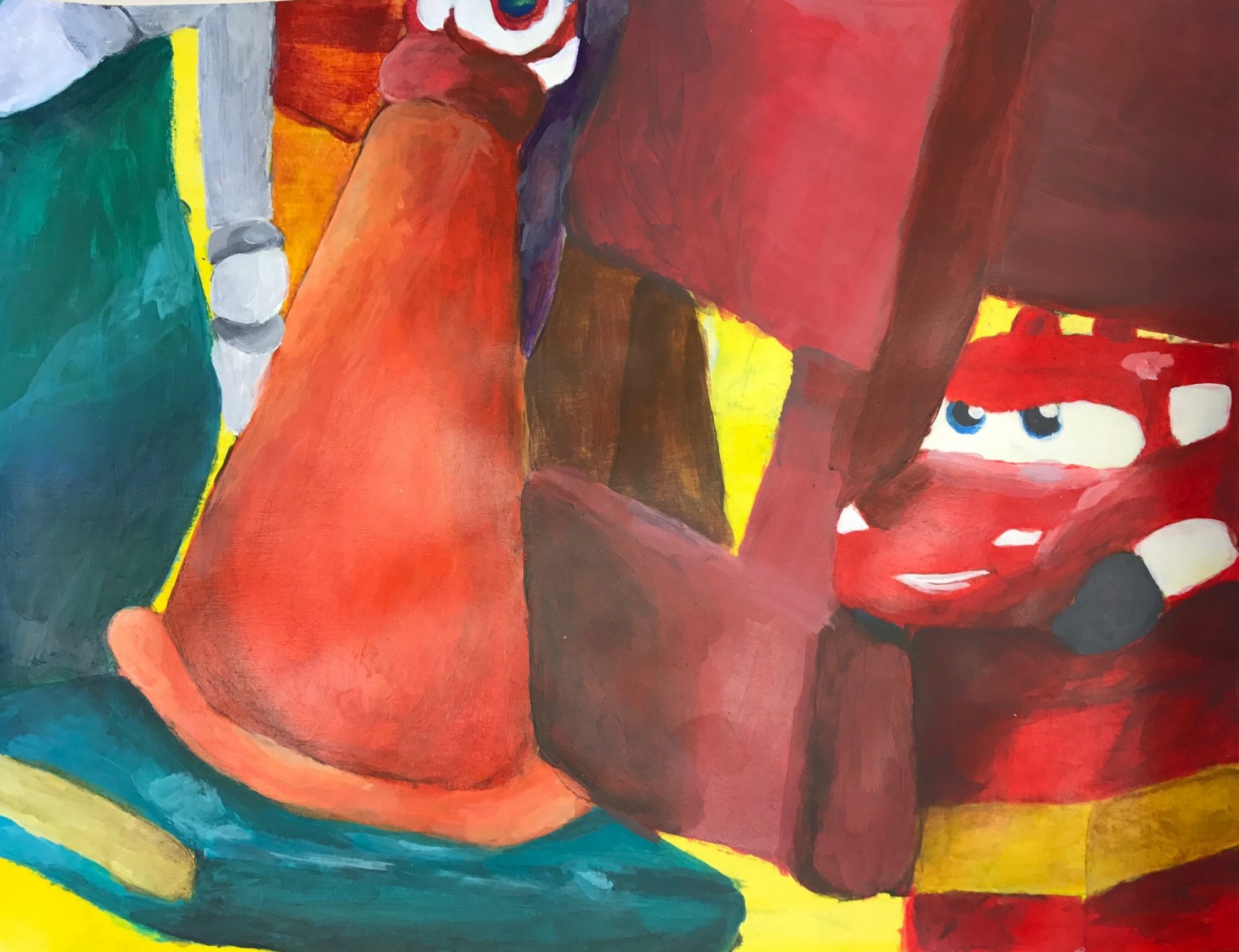
Perspective and Proportion Still Life Paintings
High school Painting and Drawing students worked on capturing light and color using acrylic paint and a handmade viewfinder to measure proportion of a still life from their perspective.
Acrylic on bristol paper
9" x 12"
2017
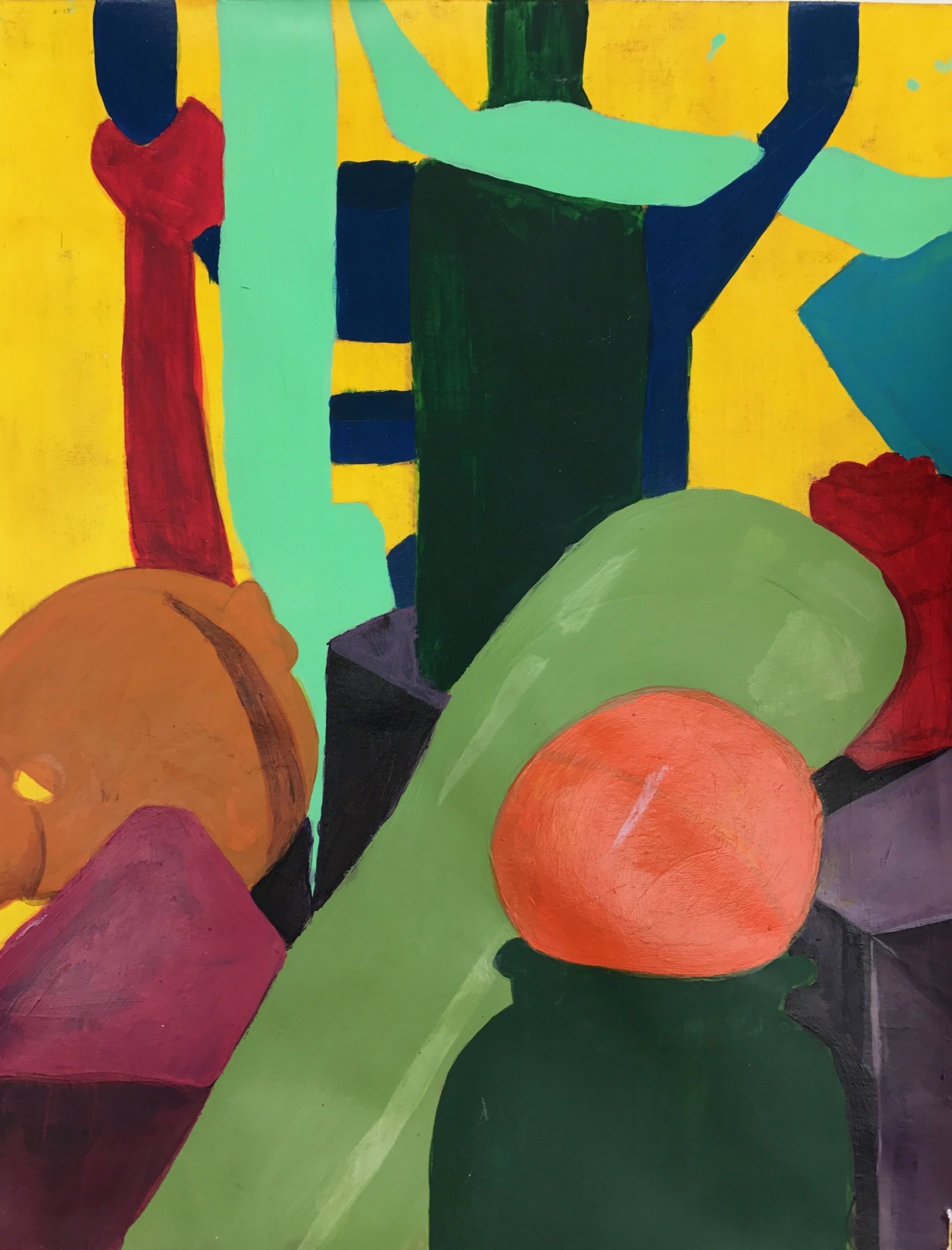
Perspective and Proportion Still Life Paintings
High school Painting and Drawing students worked on capturing light and color using acrylic paint and a handmade viewfinder to measure proportion of a still life from their perspective.
Acrylic on bristol paper
9" x 12"
2017
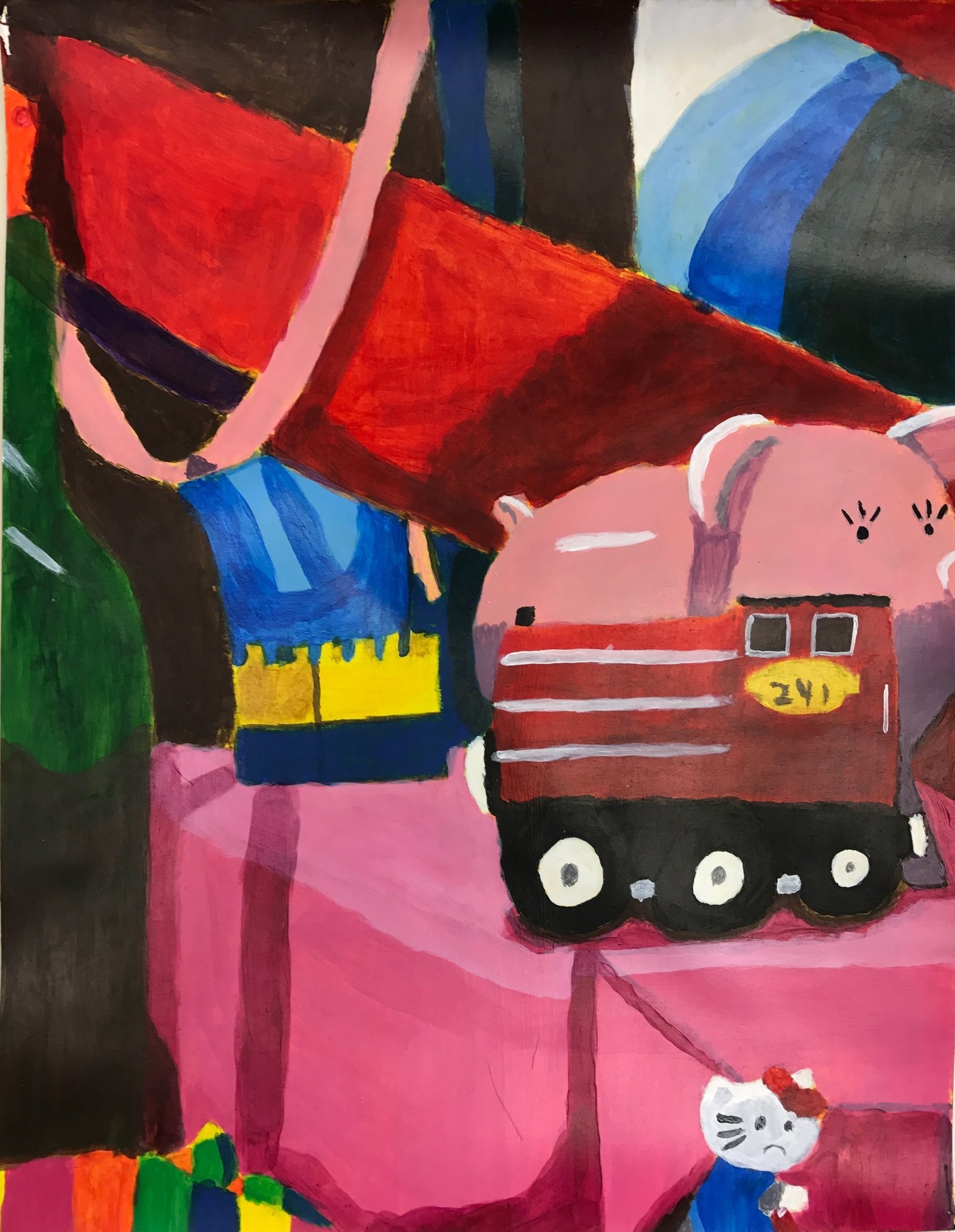
Perspective and Proportion Still Life Paintings
High school Painting and Drawing students worked on capturing light and color using acrylic paint and a handmade viewfinder to measure proportion of a still life from their perspective.
Acrylic on bristol paper
9" x 12"
2017
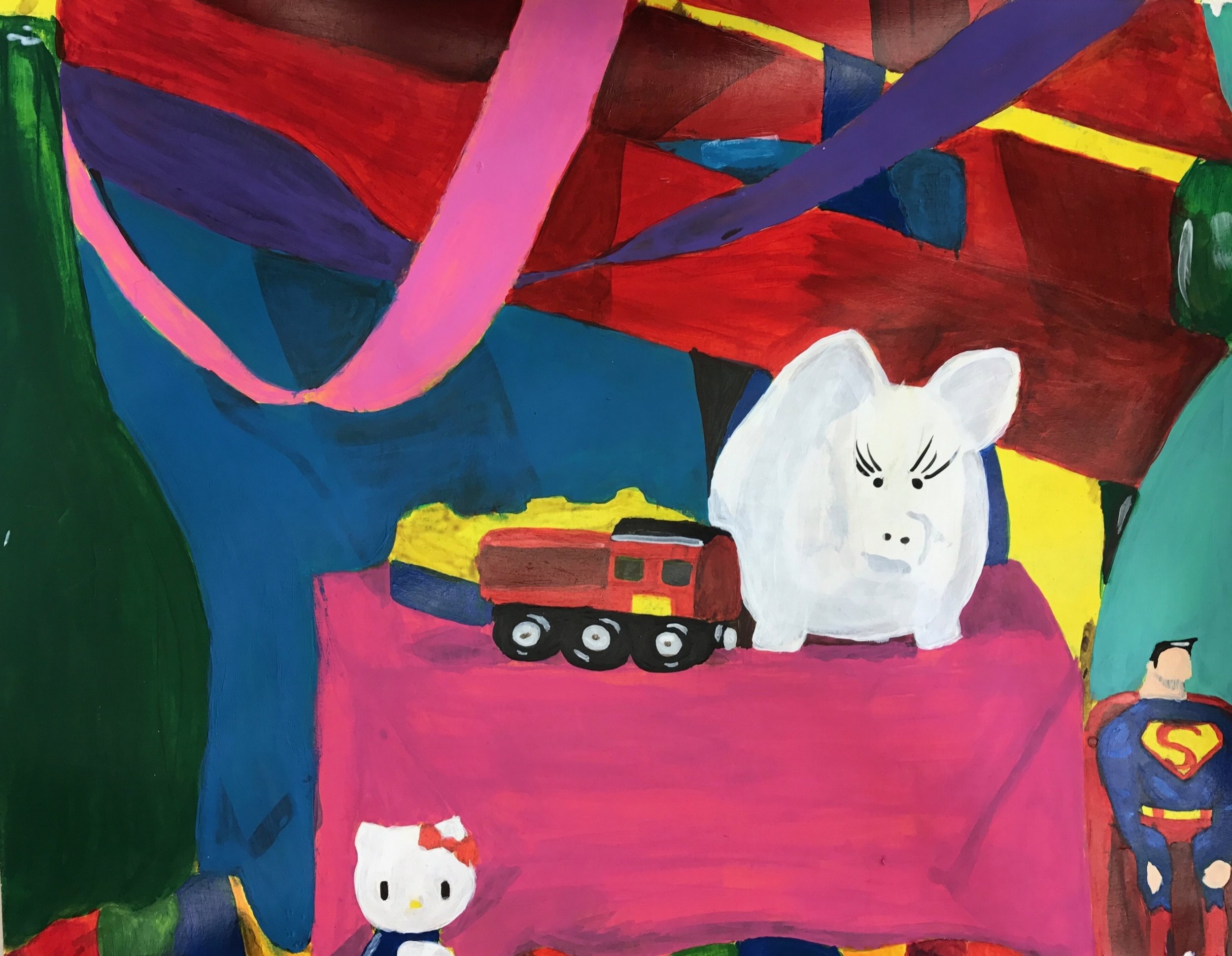
Perspective and Proportion Still Life Paintings
High school Painting and Drawing students worked on capturing light and color using acrylic paint and a handmade viewfinder to measure proportion of a still life from their perspective.
Acrylic on bristol paper
9" x 12"
2017
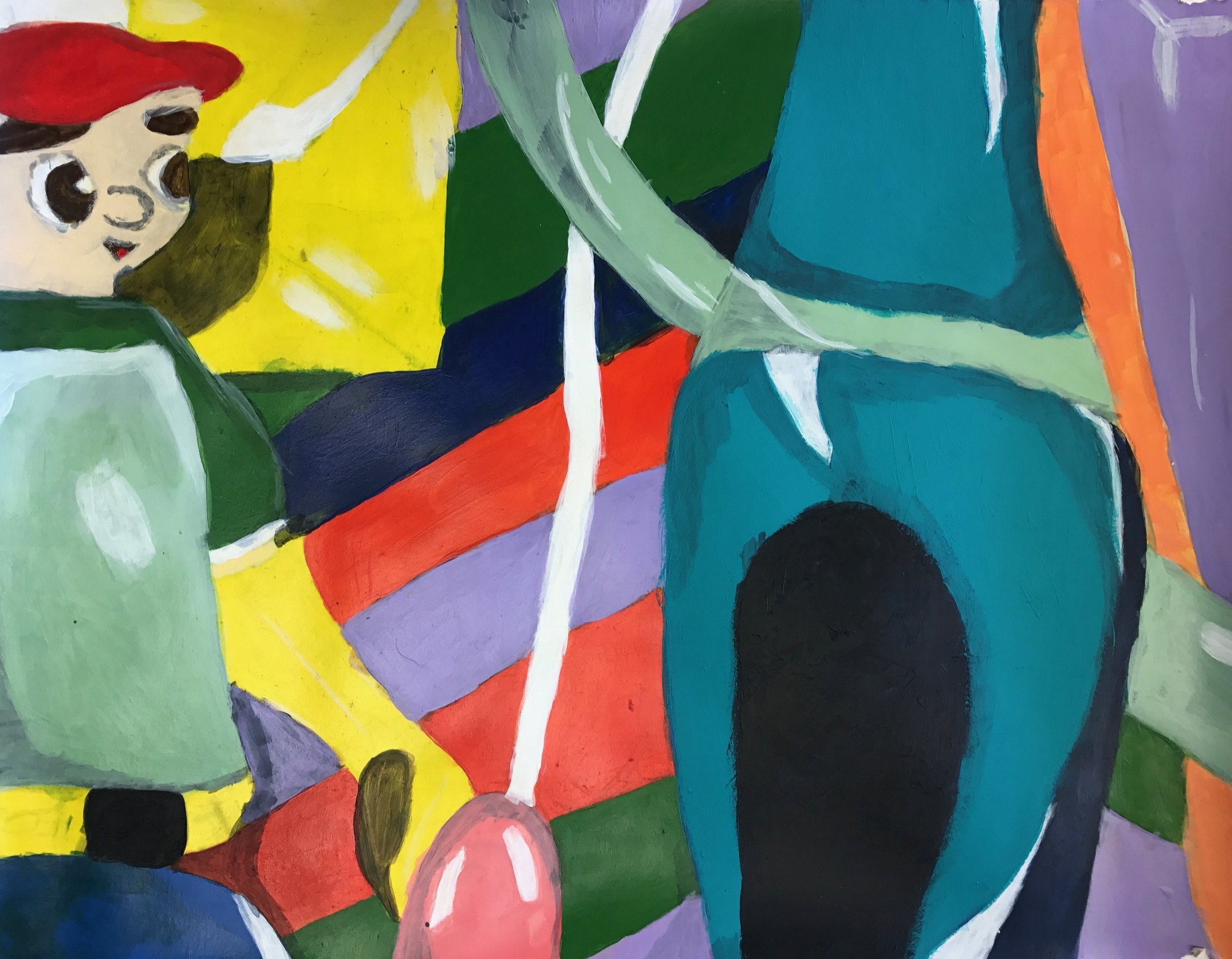
Perspective and Proportion Still Life Paintings
High school Painting and Drawing students worked on capturing light and color using acrylic paint and a handmade viewfinder to measure proportion of a still life from their perspective.
Acrylic on bristol paper
9" x 12"
2017

Perspective and Proportion Still Life Paintings support
Initial worksheet I designed and implemented as a mini lesson into color theory as it applies to acrylic paint to test student prior knowledge with the medium, as well as reinforce what they are familiar with. I demonstrated and quizzed students with this sheet - printed on cardstock to withstand the paint - on a projector.
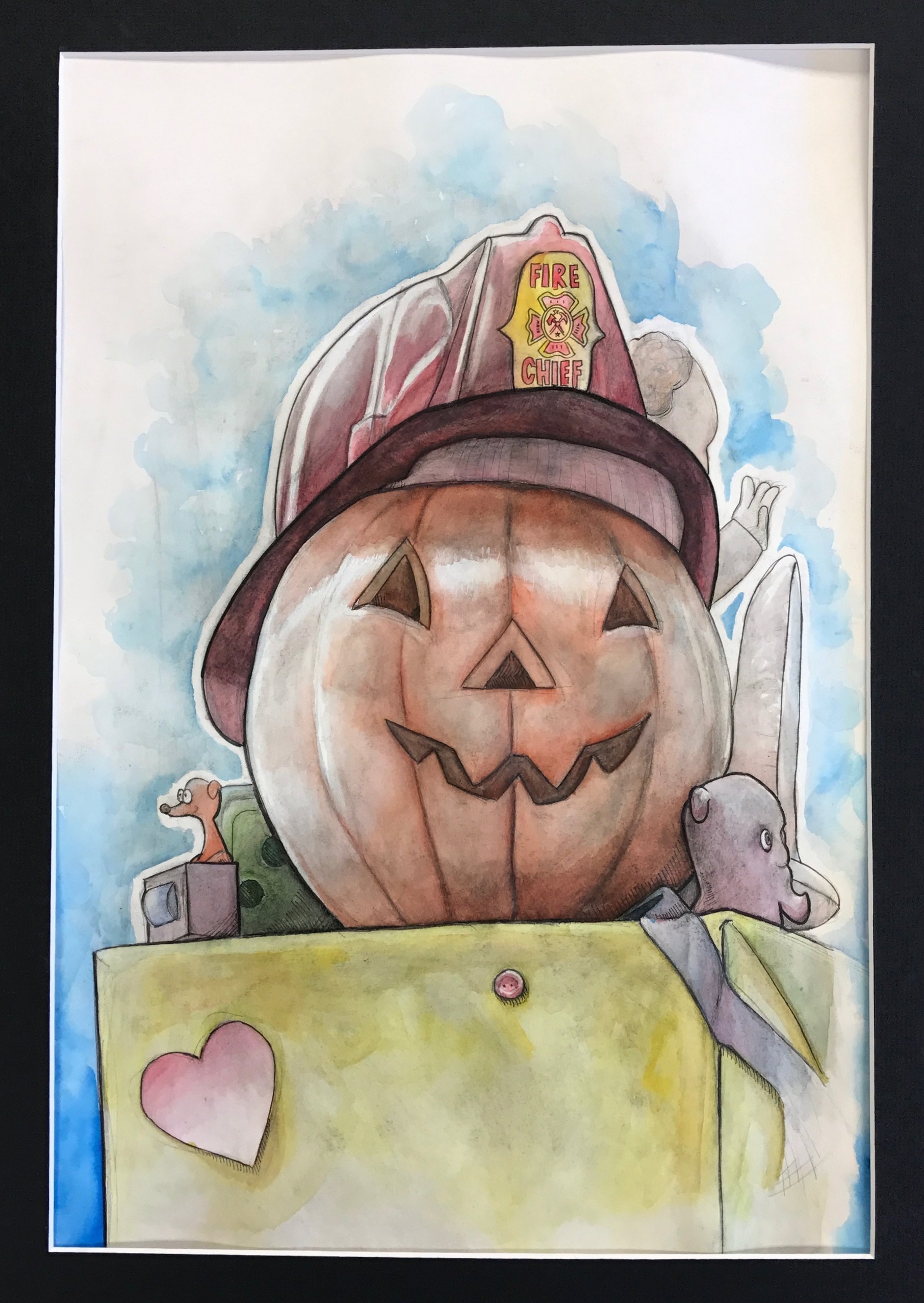
Art Emulation
Advanced art students were presented with images and a list of various contemporary artists who work in multiple media. The task was then set for students to choose an artist as inspiration to develop and produce a work in that artist's style and media working from a still life. The challenge was not only in rendering the still life, but in replicating the process of another artist.
Mixed media on bristol
12" x 16"
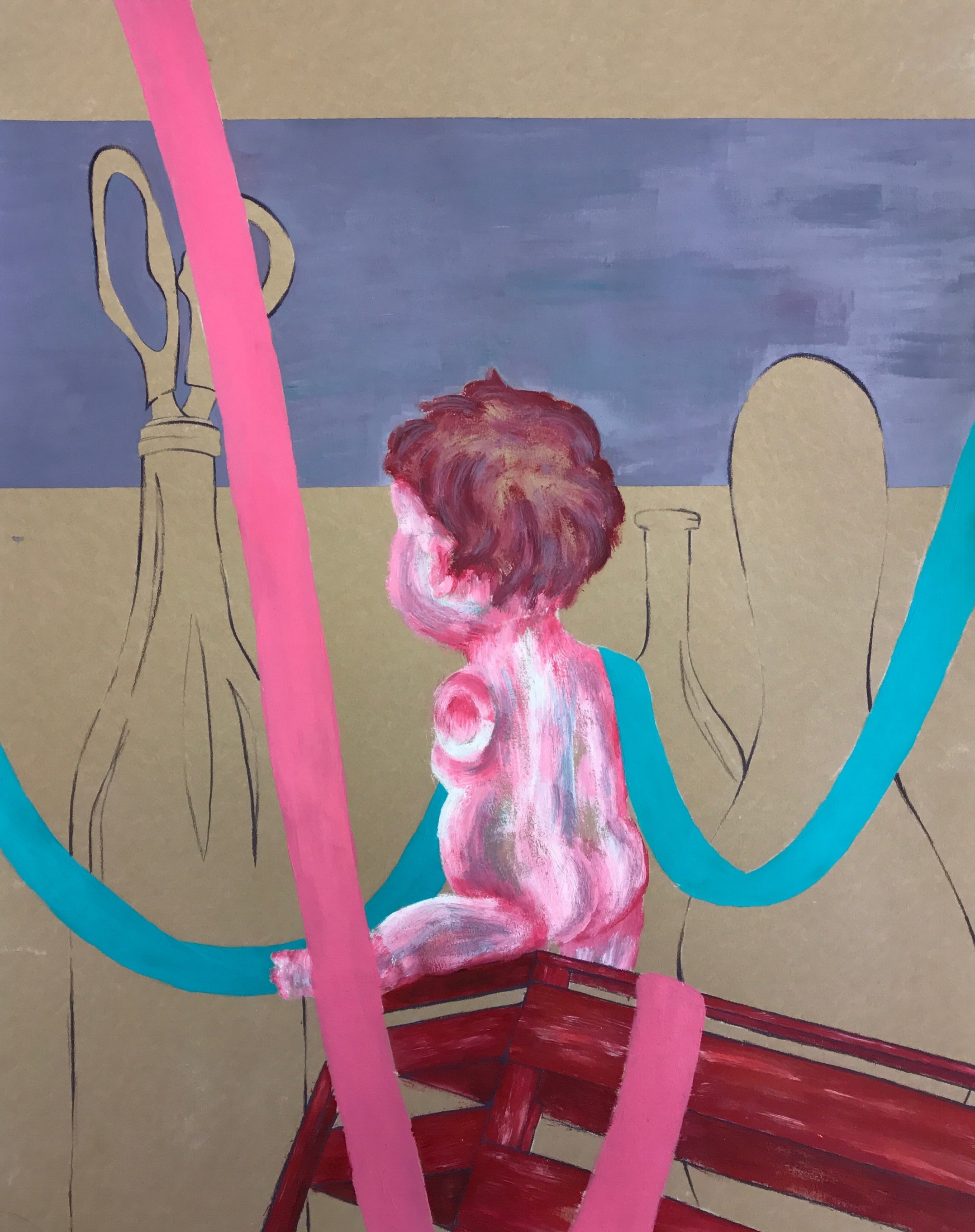
Art Emulation
Advanced art students were presented with images and a list of various contemporary artists who work in multiple media. The task was then set for students to choose an artist as inspiration to develop and produce a work in that artist's style and media working from a still life. The challenge was not only in rendering the still life, but in replicating the process of another artist.
Mixed media on charcoal paper
12" x 16"
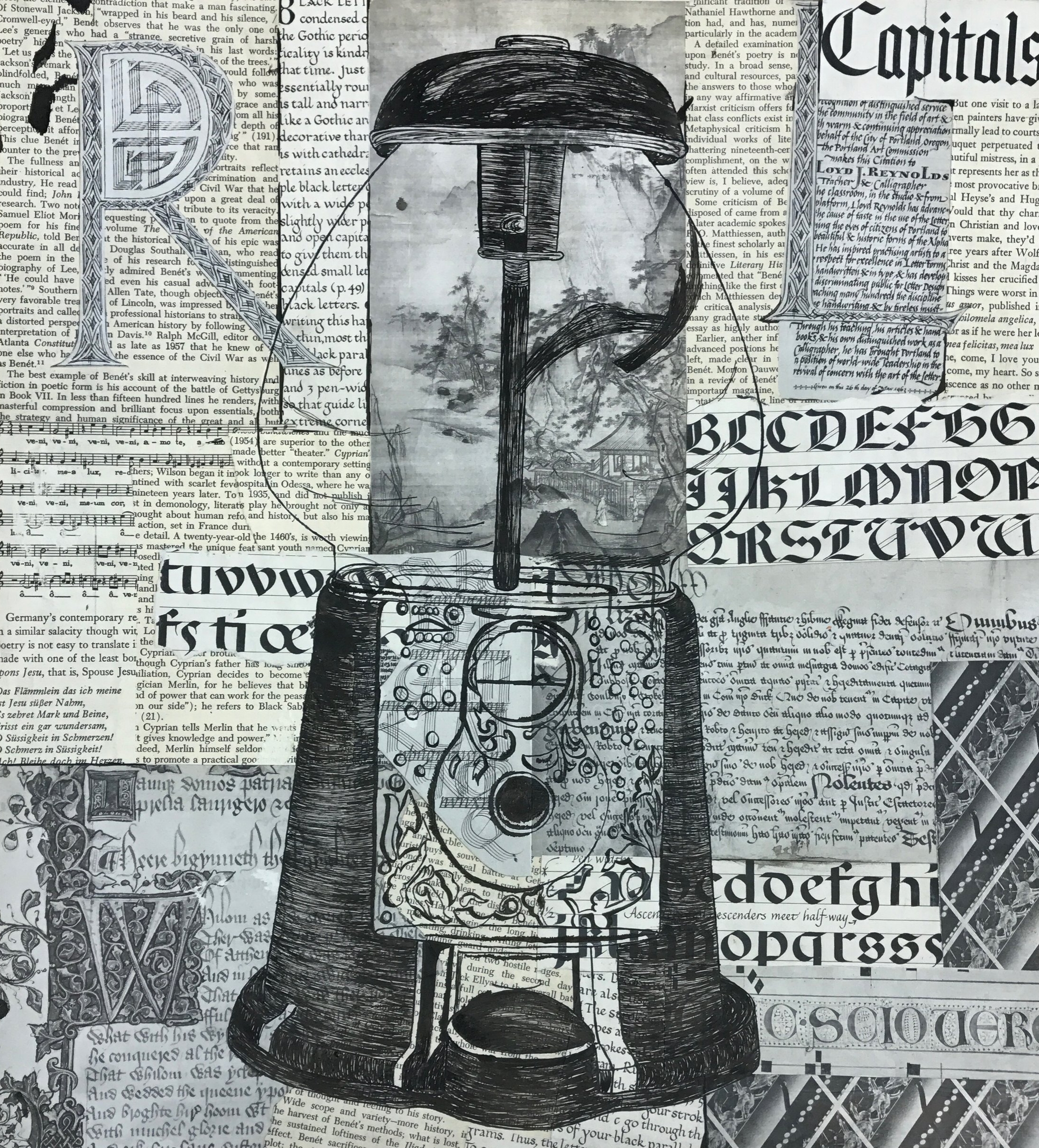
Art Emulation
Advanced art students were presented with images and a list of various contemporary artists who work in multiple media. The task was then set for students to choose an artist as inspiration to develop and produce a work in that artist's style and media working from a still life. The challenge was not only in rendering the still life, but in replicating the process of another artist.
Mixed media on bristol
12" x 14"

Art Emulation
Advanced art students were presented with images and a list of various contemporary artists who work in multiple media. The task was then set for students to choose an artist as inspiration to develop and produce a work in that artist's style and media working from a still life. The challenge was not only in rendering the still life, but in replicating the process of another artist.
Mixed media on cardboard
12" x 14"
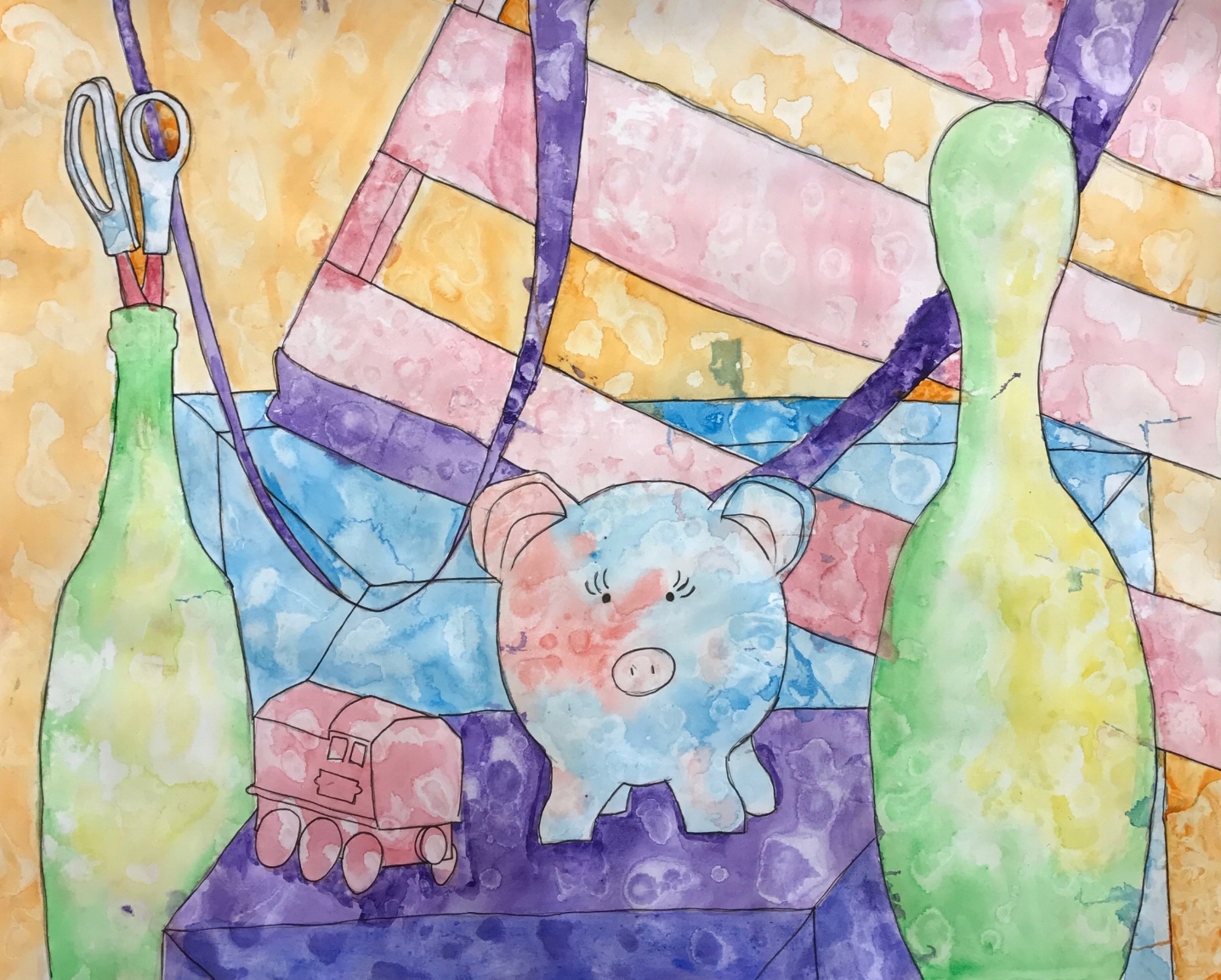
Art Emulation
Advanced art students were presented with images and a list of various contemporary artists who work in multiple media. The task was then set for students to choose an artist as inspiration to develop and produce a work in that artist's style and media working from a still life. The challenge was not only in rendering the still life, but in replicating the process of another artist.
Mixed media on bristol
12" x 16"
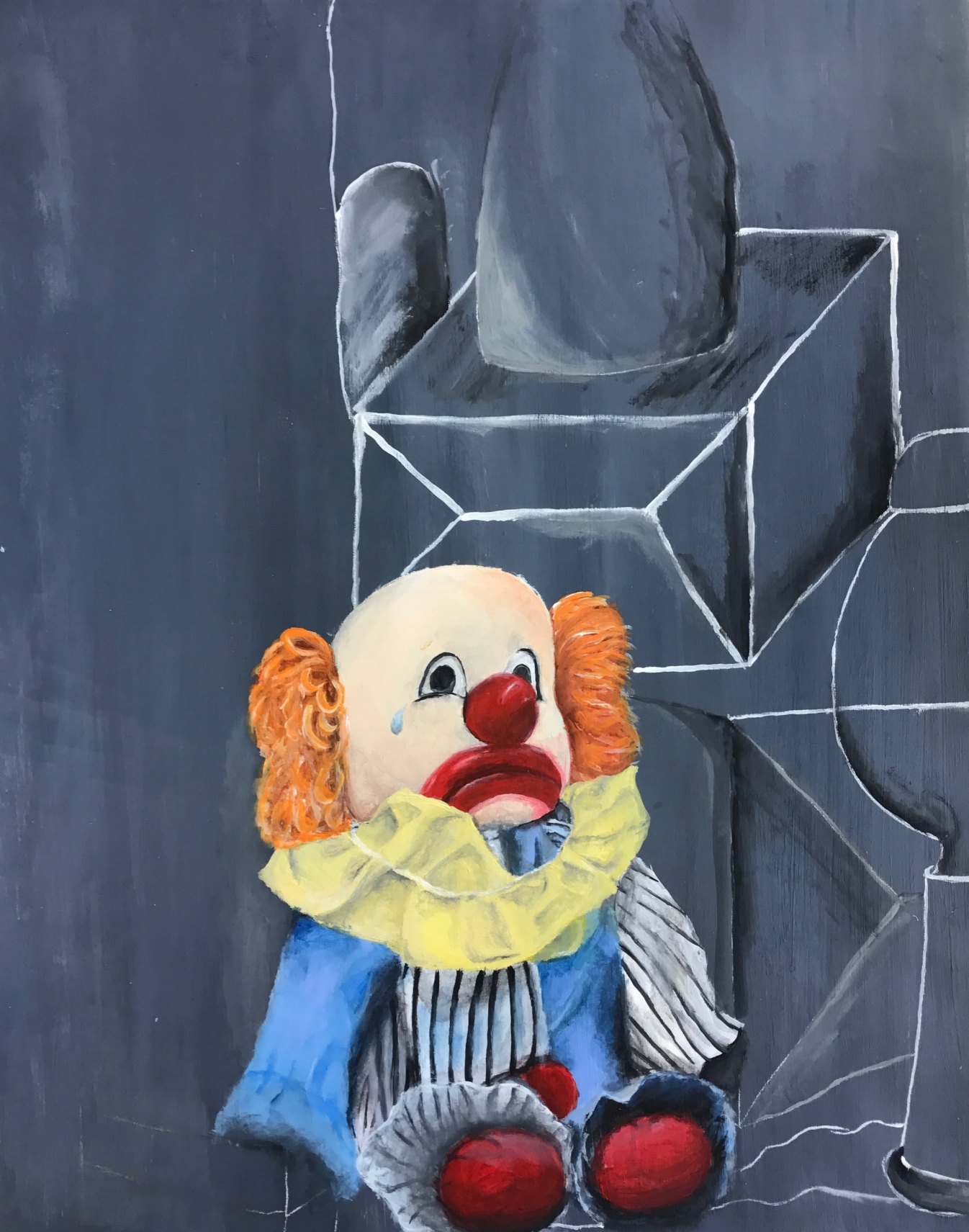
Art Emulation
Advanced art students were presented with images and a list of various contemporary artists who work in multiple media. The task was then set for students to choose an artist as inspiration to develop and produce a work in that artist's style and media working from a still life. The challenge was not only in rendering the still life, but in replicating the process of another artist.
Mixed media on bristol
12" x 16"
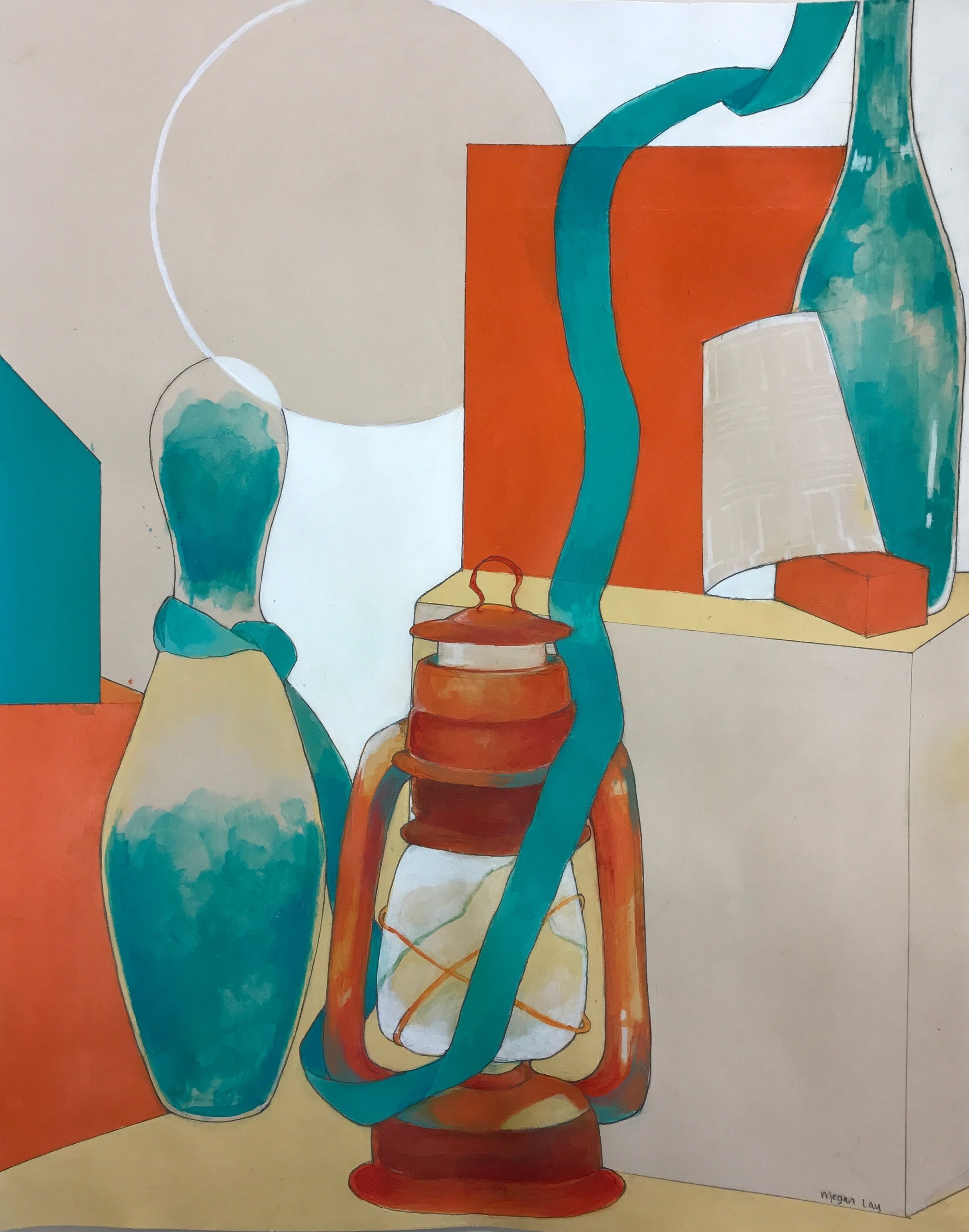
Art Emulation
Advanced art students were presented with images and a list of various contemporary artists who work in multiple media. The task was then set for students to choose an artist as inspiration to develop and produce a work in that artist's style and media working from a still life. The challenge was not only in rendering the still life, but in replicating the process of another artist.
Mixed media on charcoal paper
12" x 16"

Constraints and Concepts 1 day lesson
AP and Advanced art students took a day to investigate constraints and concepts inspired by the work of On Kawara. Their task, illustrated in this spread, challenged students to limit what materials they used as well as working within set parameters of time and size.

Constraints and Concepts 1 day lesson
AP and Advanced art students took a day to investigate constraints and concepts inspired by the work of On Kawara. Their task, illustrated in this spread, challenged students to limit what materials they used as well as working within set parameters of time and size.
Mixed media
4" x 4"

Constraints and Concepts 1 day lesson
AP and Advanced art students took a day to investigate constraints and concepts inspired by the work of On Kawara. Their task, illustrated in this spread, challenged students to limit what materials they used as well as working within set parameters of time and size.
Mixed media
4" x 4"
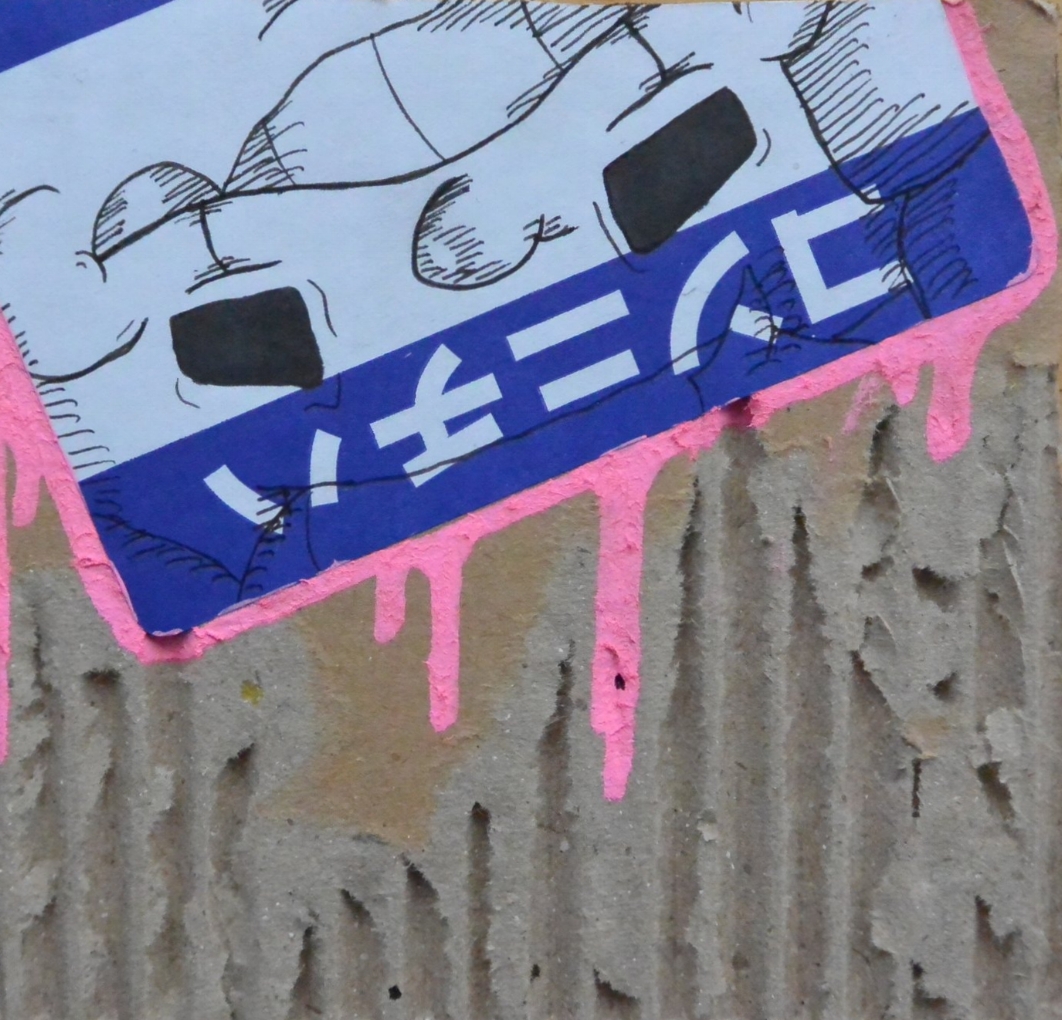
Constraints and Concepts 1 day lesson
AP and Advanced art students took a day to investigate constraints and concepts inspired by the work of On Kawara. Their task, illustrated in this spread, challenged students to limit what materials they used as well as working within set parameters of time and size.
Mixed media
4" x 4"

Constraints and Concepts 1 day lesson
AP and Advanced art students took a day to investigate constraints and concepts inspired by the work of On Kawara. Their task, illustrated in this spread, challenged students to limit what materials they used as well as working within set parameters of time and size.
Mixed media
4" x 4"

Constraints and Concepts 1 day lesson
AP and Advanced art students took a day to investigate constraints and concepts inspired by the work of On Kawara. Their task, illustrated in this spread, challenged students to limit what materials they used as well as working within set parameters of time and size.
Mixed media
4" x 4"

Constraints and Concepts 1 day lesson
AP and Advanced art students took a day to investigate constraints and concepts inspired by the work of On Kawara. Their task, illustrated in this spread, challenged students to limit what materials they used as well as working within set parameters of time and size.
Mixed media
4" x 4"

Constraints and Concepts 1 day lesson
AP and Advanced art students took a day to investigate constraints and concepts inspired by the work of On Kawara. Their task, illustrated in this spread, challenged students to limit what materials they used as well as working within set parameters of time and size.
Mixed media
4" x 4"

Constraints and Concepts 1 day lesson
AP and Advanced art students took a day to investigate constraints and concepts inspired by the work of On Kawara. Their task, illustrated in this spread, challenged students to limit what materials they used as well as working within set parameters of time and size.
Mixed media
4" x 4"

After: Work from Instructions (1971)
AP and Advanced art students took a day to investigate constraints and concepts inspired by the work of Sol LeWitt. Their task, illustrated in this spread, challenged students to interpret limiting yet open directions resulting in a variety of finished pieces.
Mixed media
10" x 10"

After: Work from Instructions (1971)
AP and Advanced art students took a day to investigate constraints and concepts inspired by the work of Sol LeWitt. Their task, illustrated in this spread, challenged students to interpret limiting yet open directions resulting in a variety of finished pieces.
Mixed media
10" x 10"

After: Work from Instructions (1971)
AP and Advanced art students took a day to investigate constraints and concepts inspired by the work of Sol LeWitt. Their task, illustrated in this spread, challenged students to interpret limiting yet open directions resulting in a variety of finished pieces.
Mixed media
10" x 10"

After: Work from Instructions (1971)
AP and Advanced art students took a day to investigate constraints and concepts inspired by the work of Sol LeWitt. Their task, illustrated in this spread, challenged students to interpret limiting yet open directions resulting in a variety of finished pieces.
Mixed media
10" x 10"

Charcoal drawing lesson supports
Step-by-step visual directions for students to reference as they work to complete their own drawings from life. These were also demonstrated step-by-step on a projector.
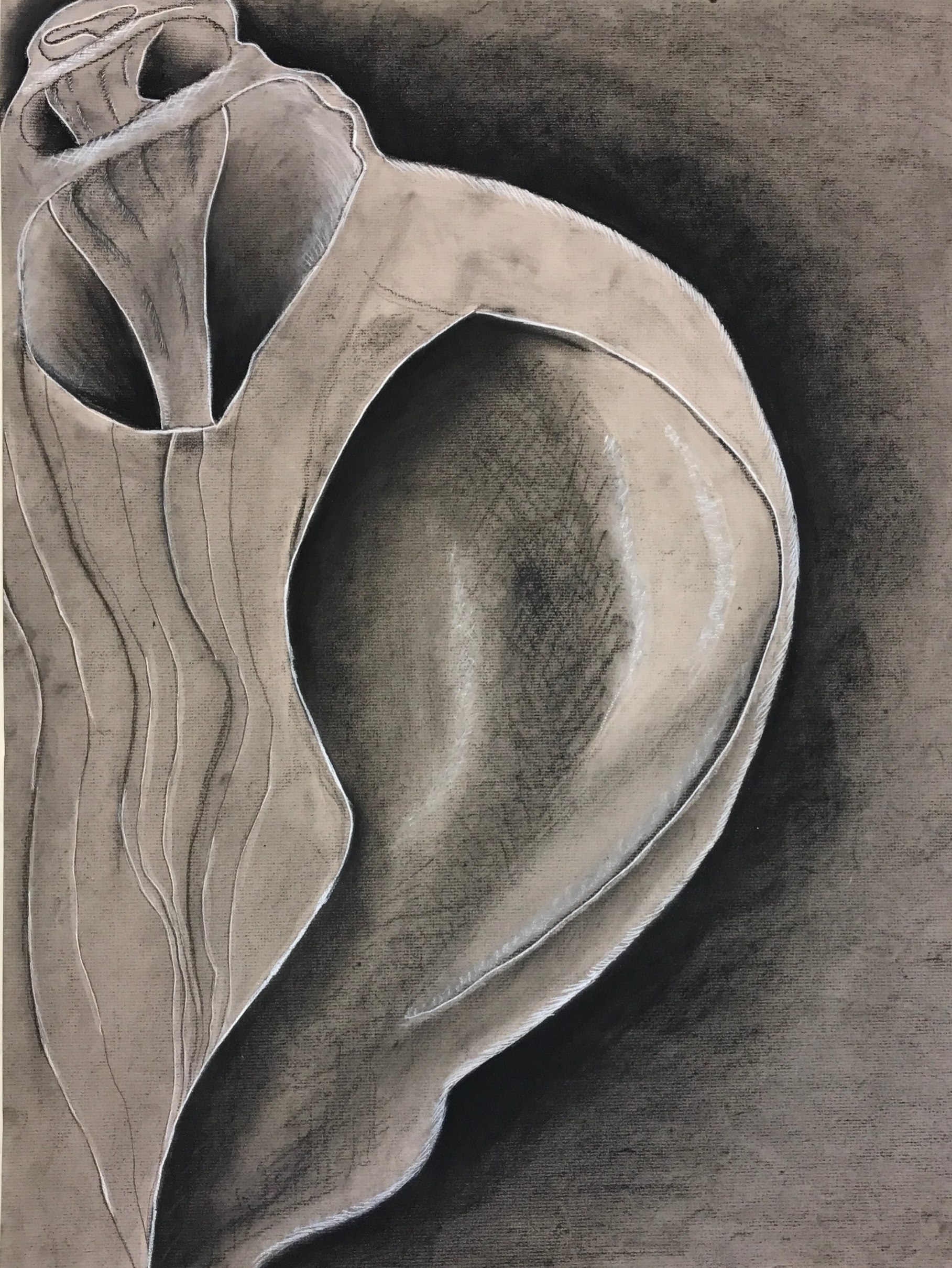
Larger than Life
High school student work from Painting and Drawing class where students used charcoal to complete a drawing of a seashell, blowing up the scale to fill the paper. Students were required to have their shells run off at least 3 edges of the paper.
Charcoal and conté on charcoal paper
20" x 24"
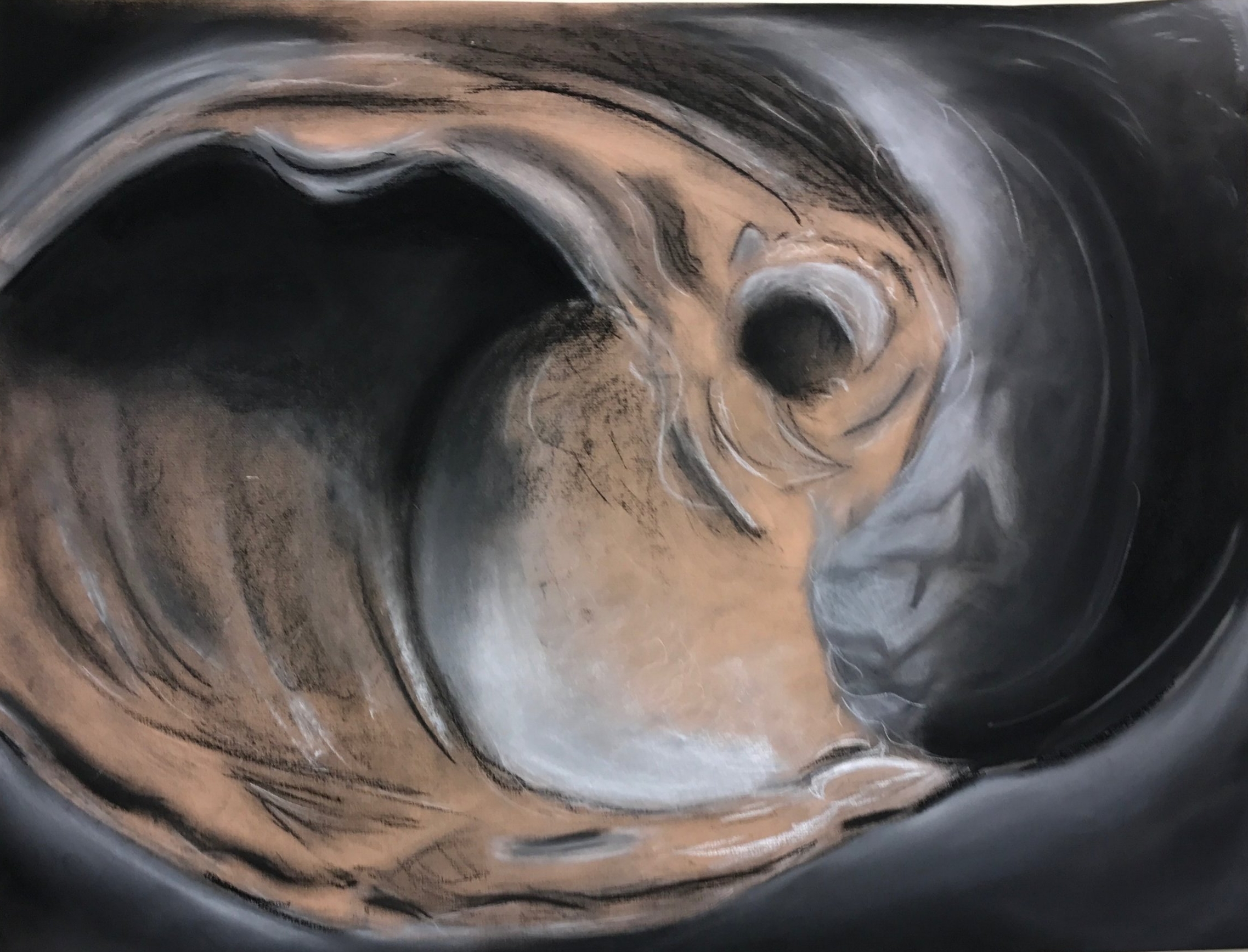
Larger than Life
High school student work from Painting and Drawing class where students used charcoal to complete a drawing of a seashell, blowing up the scale to fill the paper. Students were required to have their shells run off at least 3 edges of the paper.
Charcoal and conté on charcoal paper
20" x 24"

Larger than Life Charcoal drawing support
Self reflection worksheet to complete once student drawing is finished.
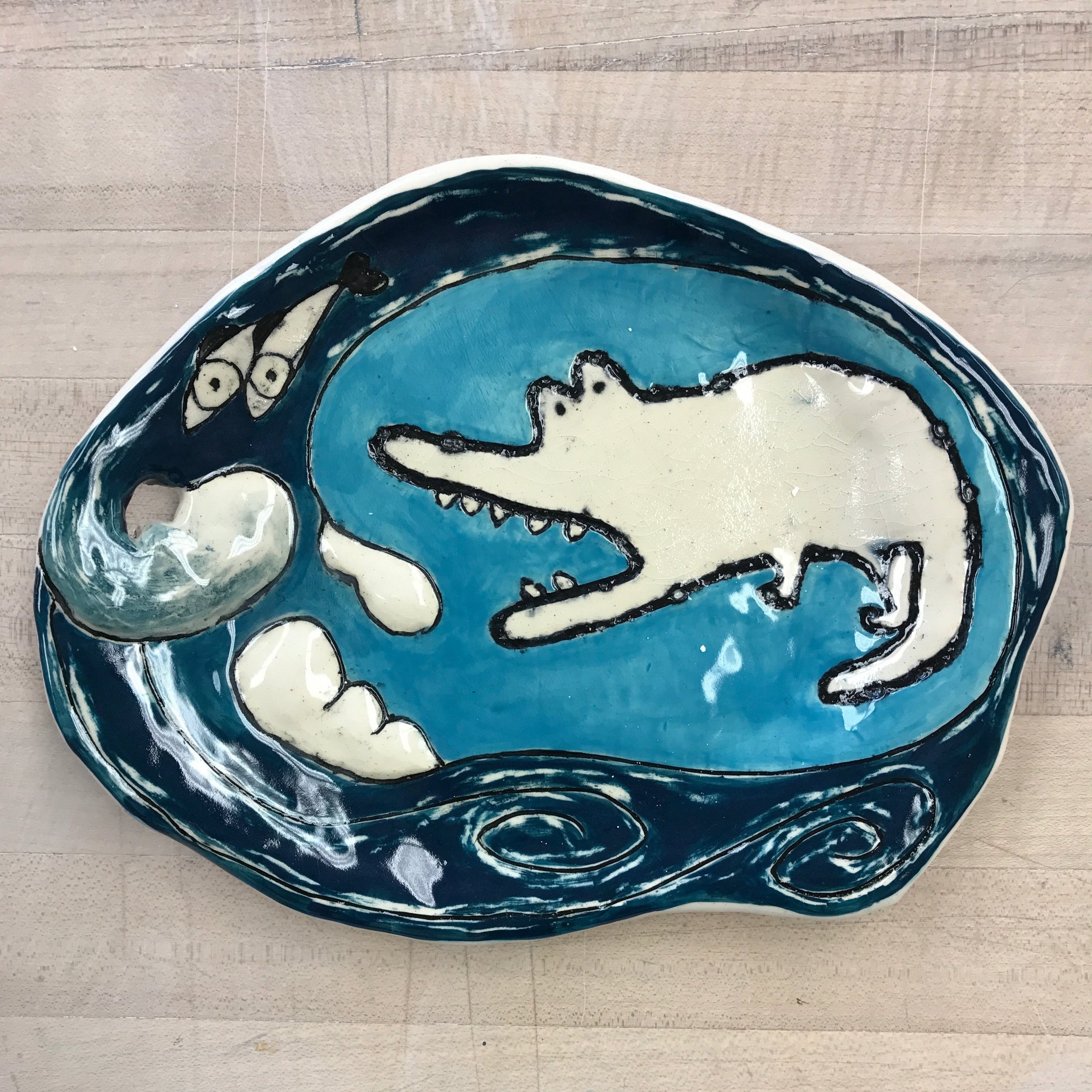
Exemplar for Slab Plates
My example for an introductory Ceramic 2 project that explores unique shapes in a simple slab form utilizing inlay and underglazing techniques to create narrative.
Earthenware, underglaze, clear glaze cone 6 oxidation
roughly 12" x 7"
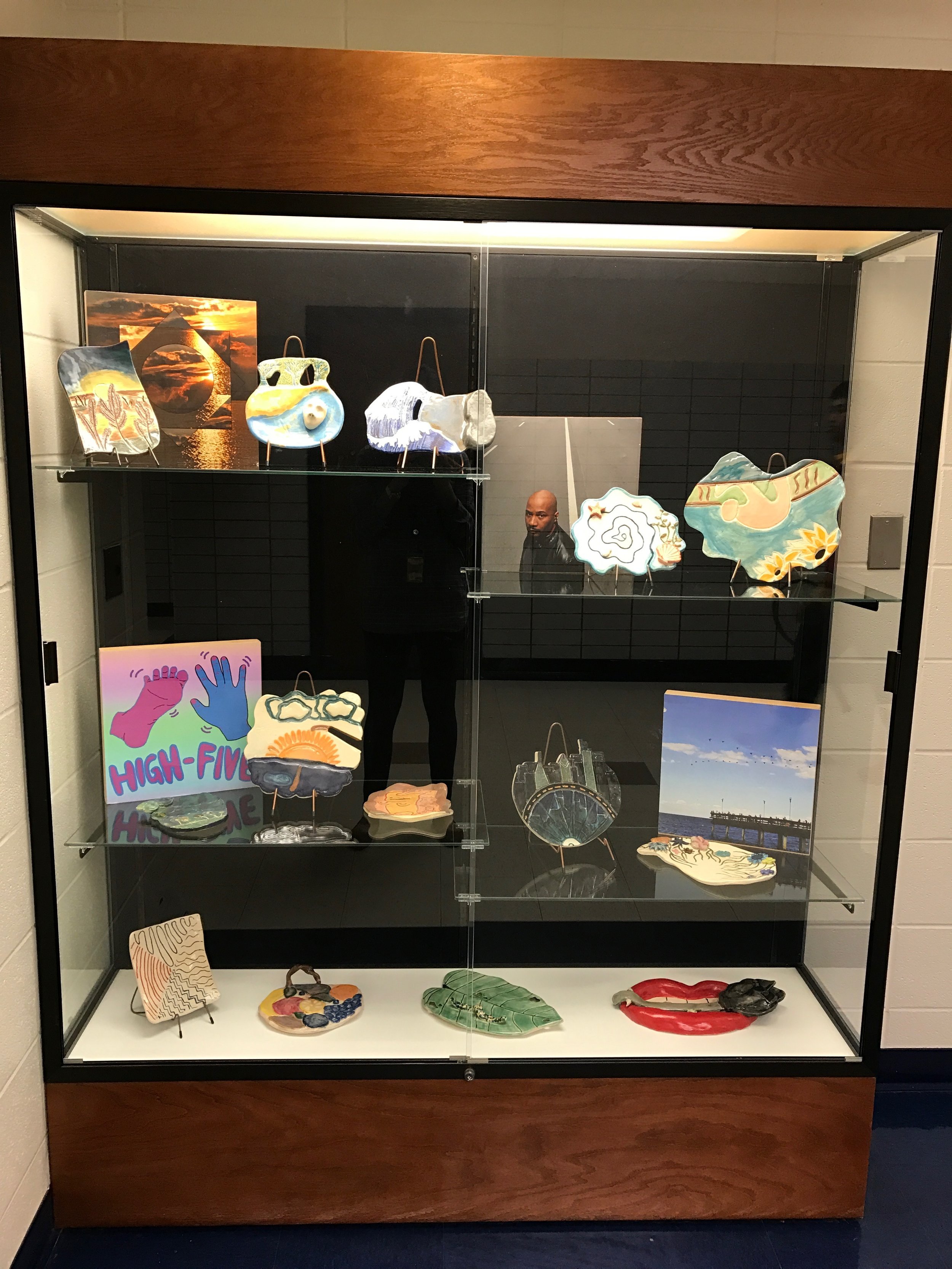
School display of Ceramic 2 student work
Display of introductory Ceramic 2 project that explores unique shapes in a simple slab form utilizing inlay and underglazing techniques to create narrative.
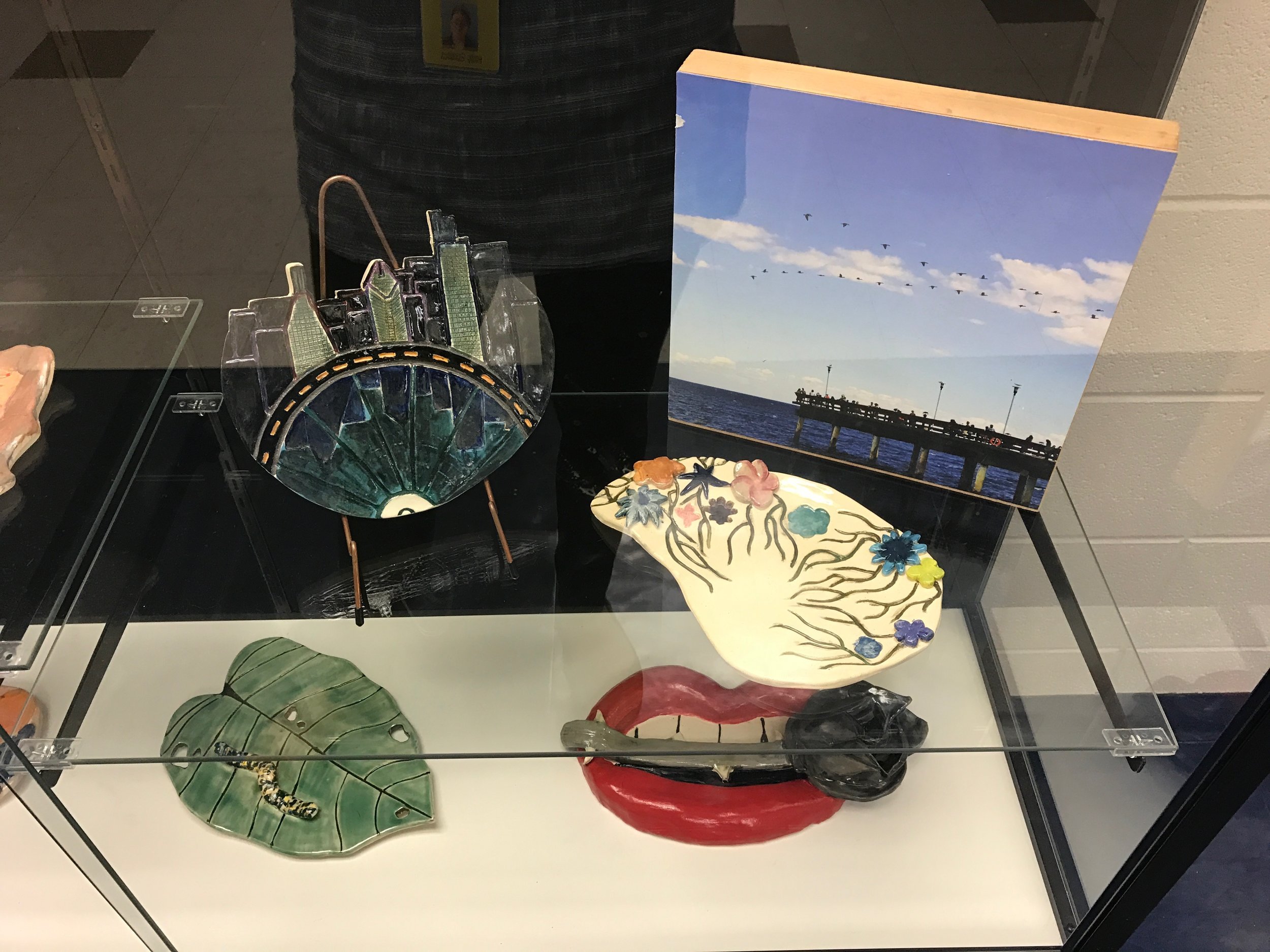
Display case of student work
Display of introductory Ceramic 2 project that explores unique shapes in a simple slab form utilizing inlay and underglazing techniques.
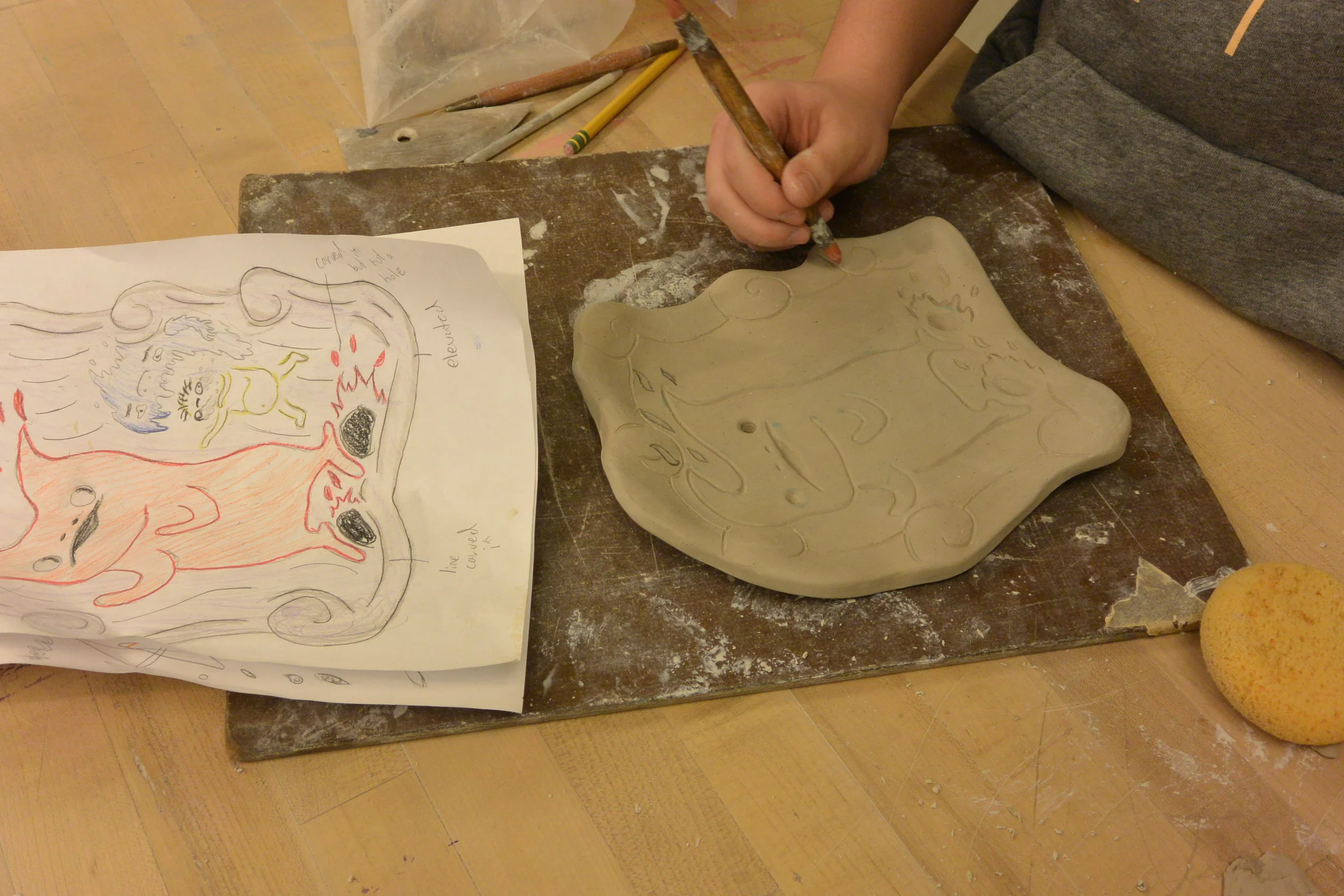
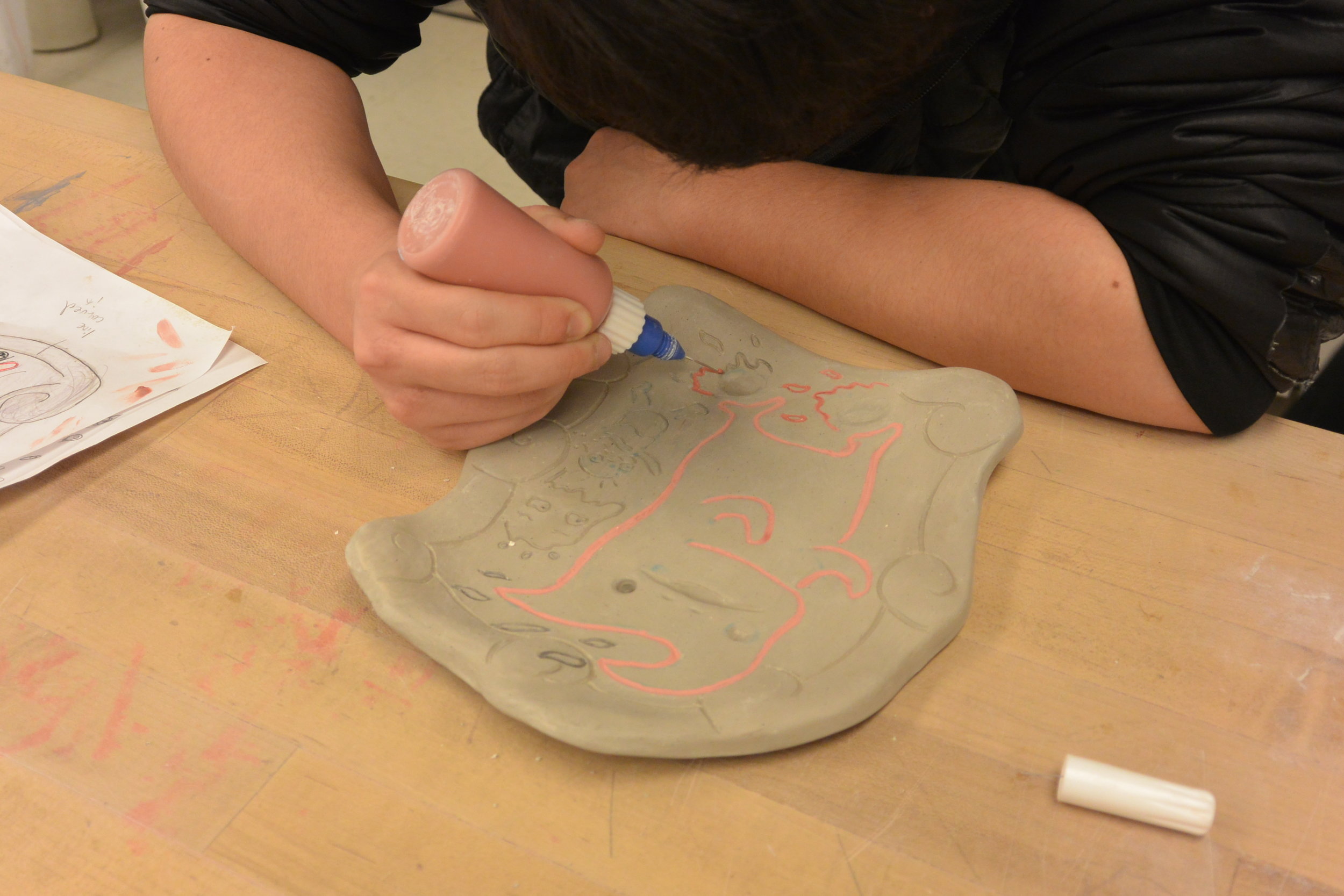
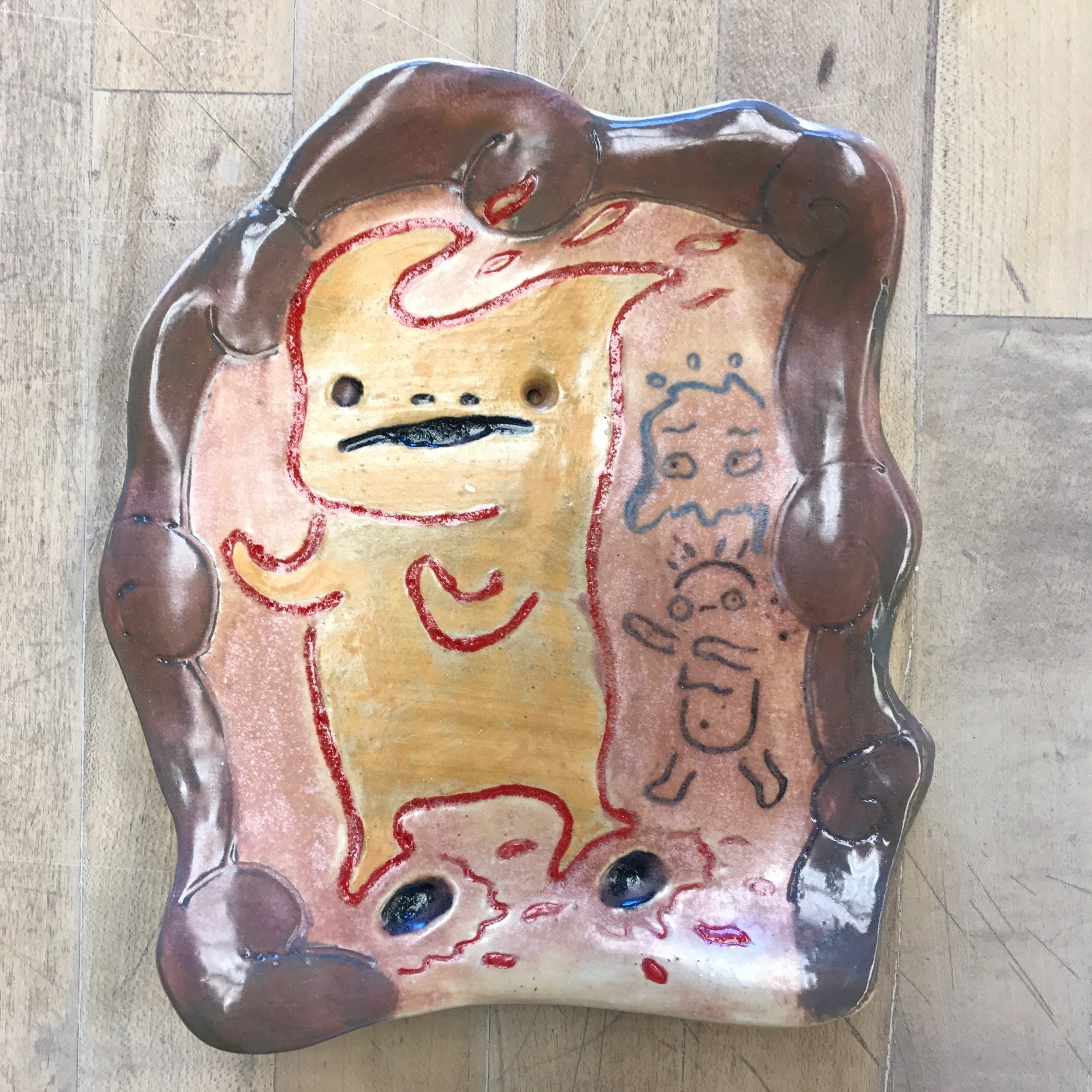
Slab Plates
Ceramic 2 student work that explores unique shapes in a simple slab form utilizing inlay and underglazing techniques to create narrative.
Earthenware, underglaze, clear glaze cone 6 oxidation
roughly 5" x 7"
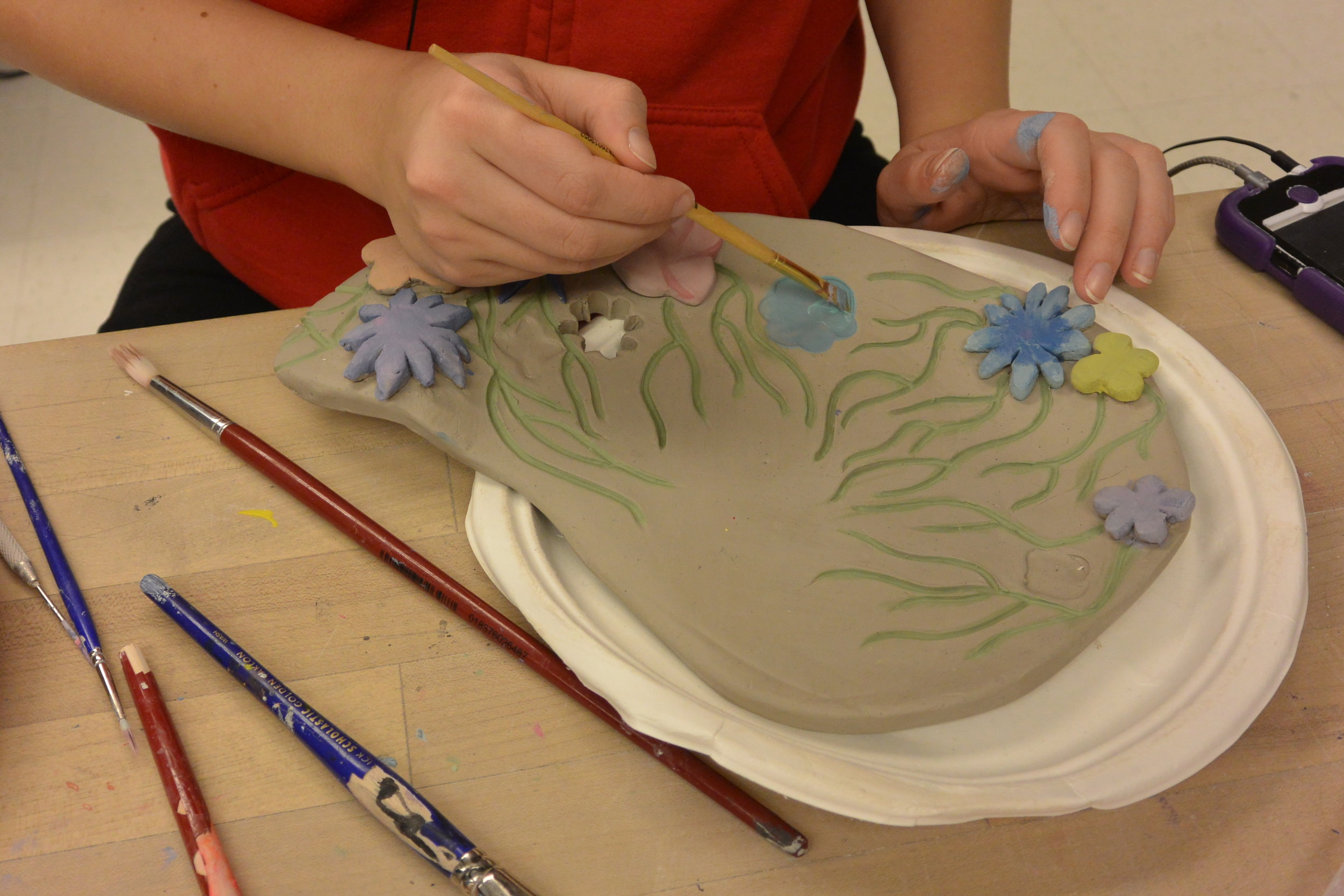

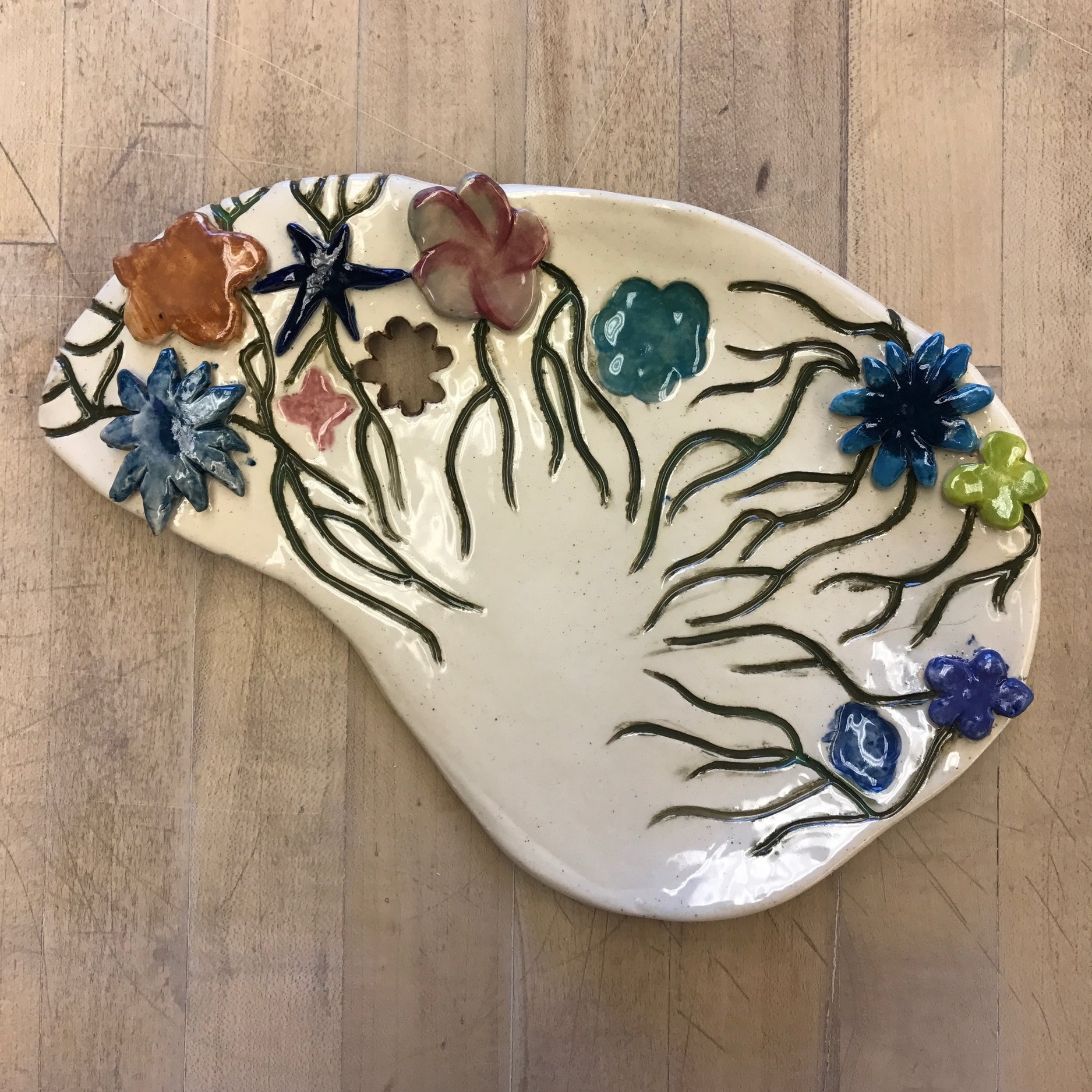
Slab Plates
Ceramic 2 student work that explores unique shapes in a simple slab form utilizing inlay and underglazing techniques to create narrative.
Earthenware, underglaze, clear glaze cone 6 oxidation
roughly 12" x 7"
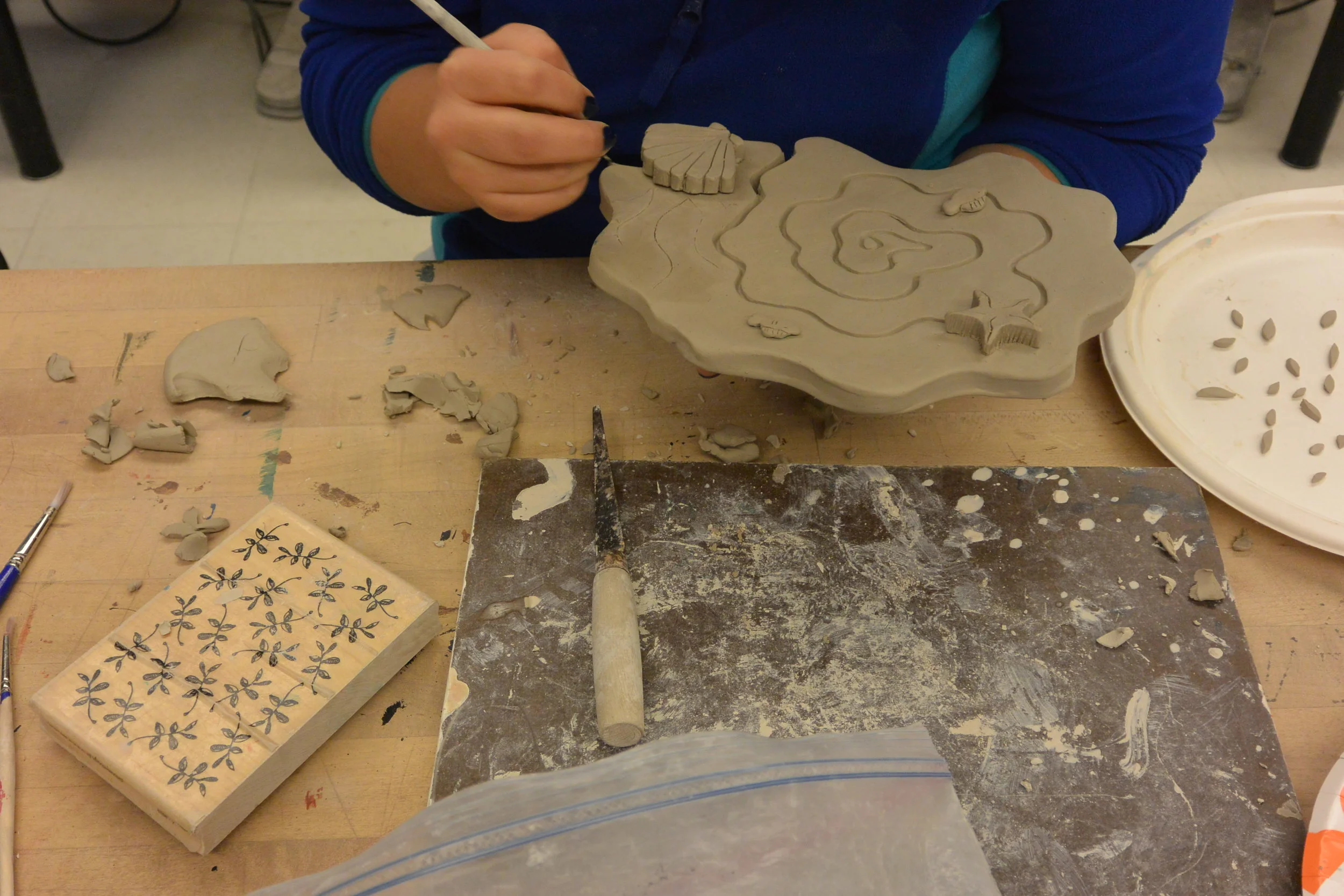
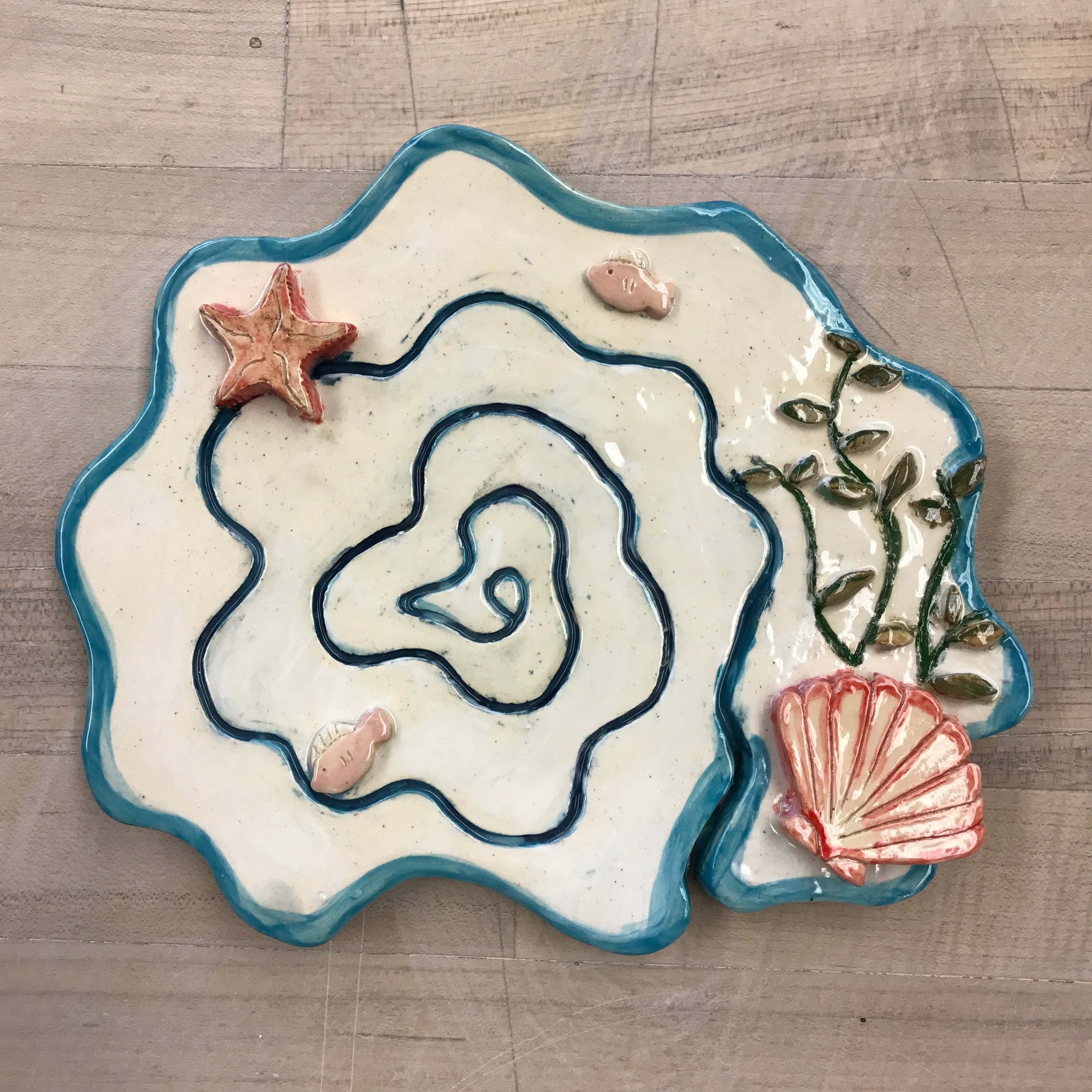
Slab Plates
Ceramic 2 student work that explores unique shapes in a simple slab form utilizing inlay and underglazing techniques to create narrative.
Earthenware, underglaze, clear glaze cone 6 oxidation
roughly 8" x 7"
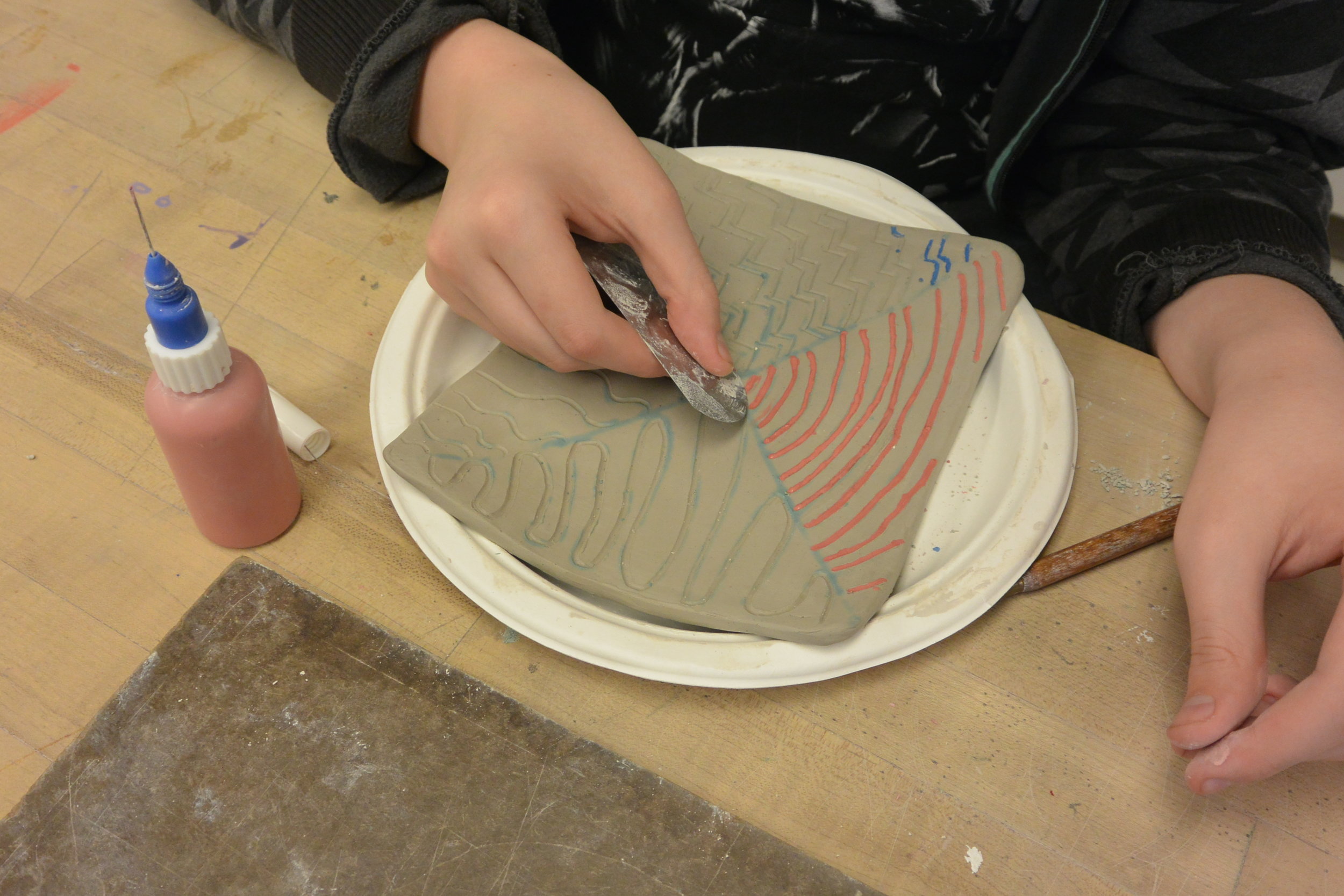
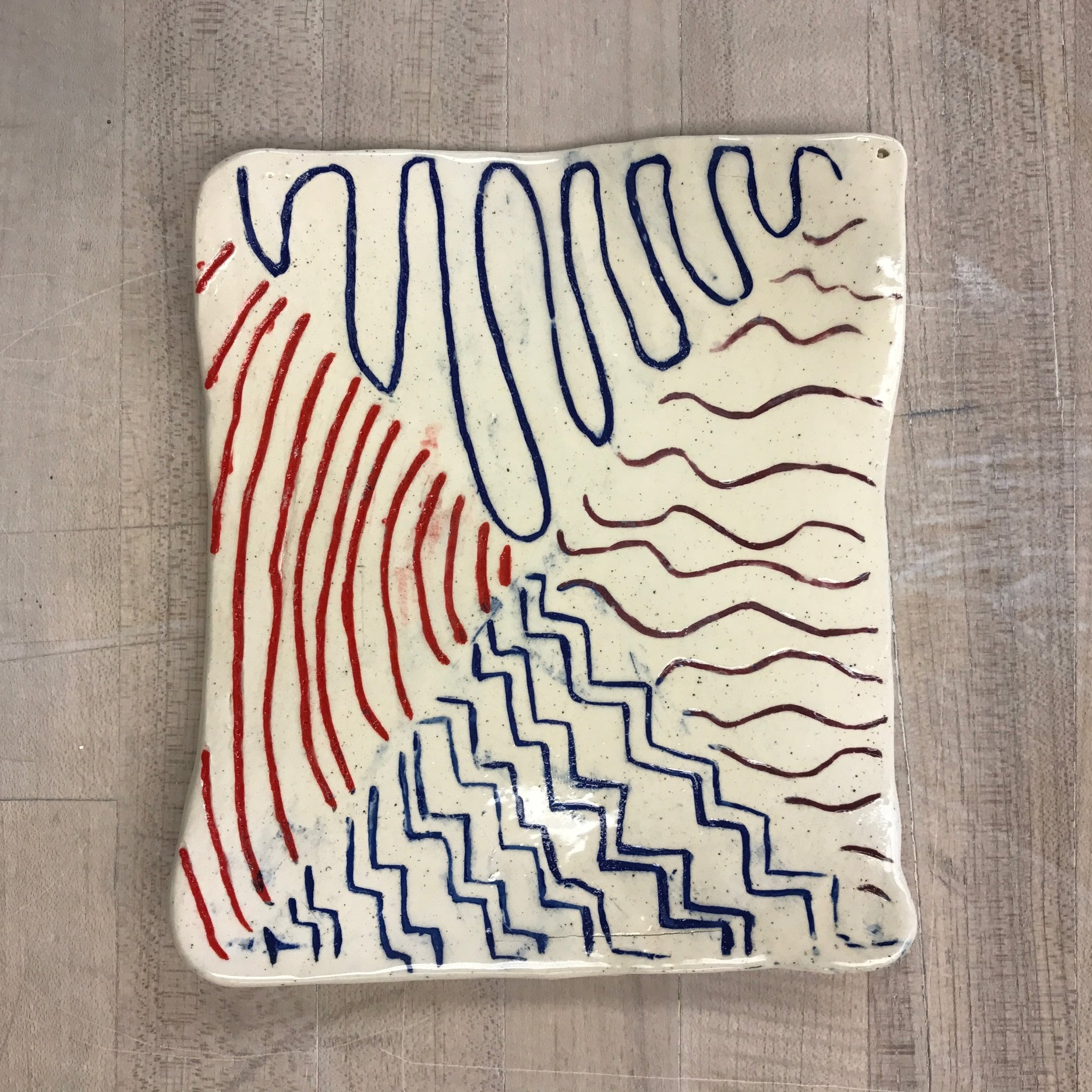
Slab Plates
Ceramic 2 student work that explores unique shapes in a simple slab form utilizing inlay and underglazing techniques to create narrative.
Earthenware, underglaze, clear glaze cone 6 oxidation
roughly 5" x 7"
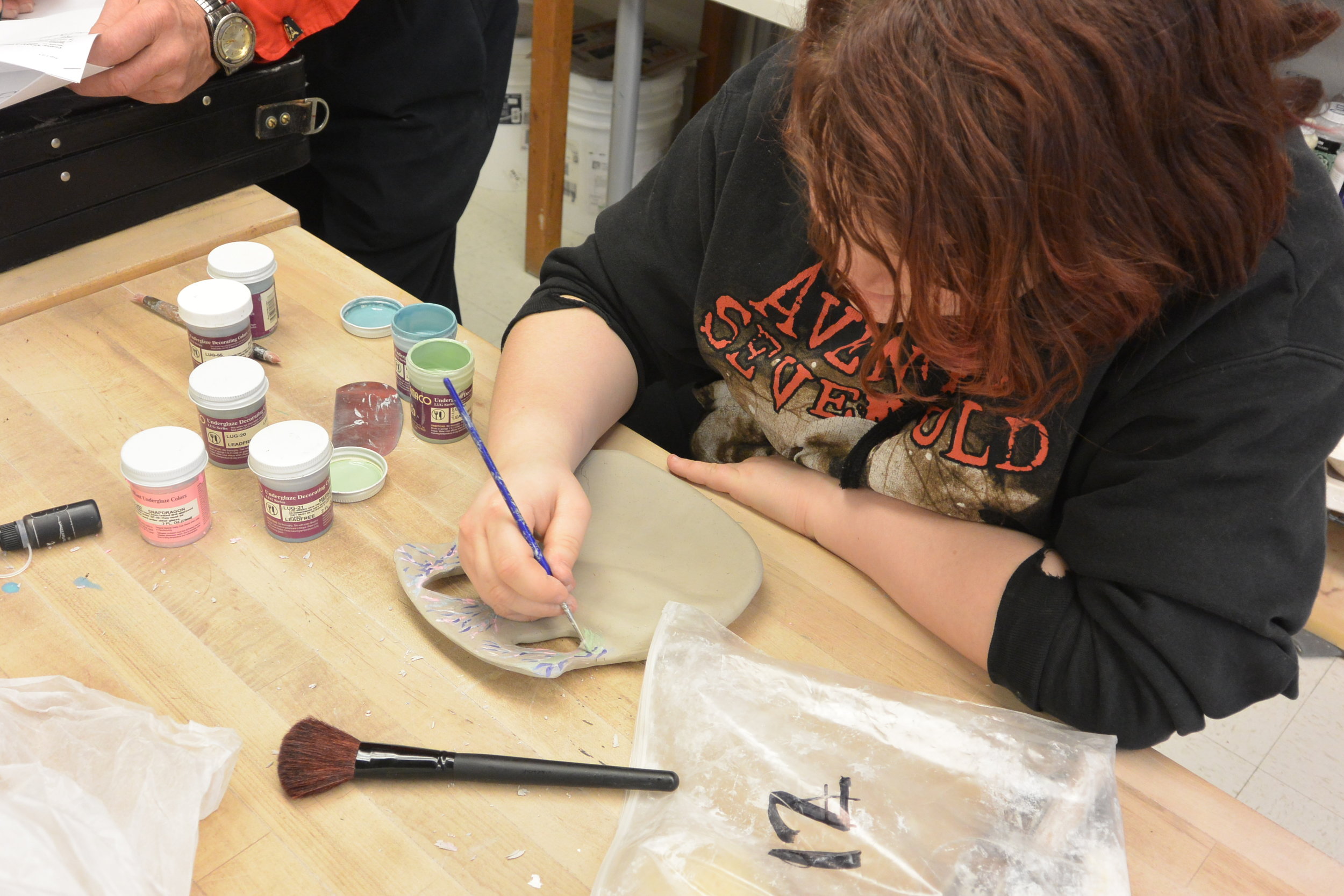
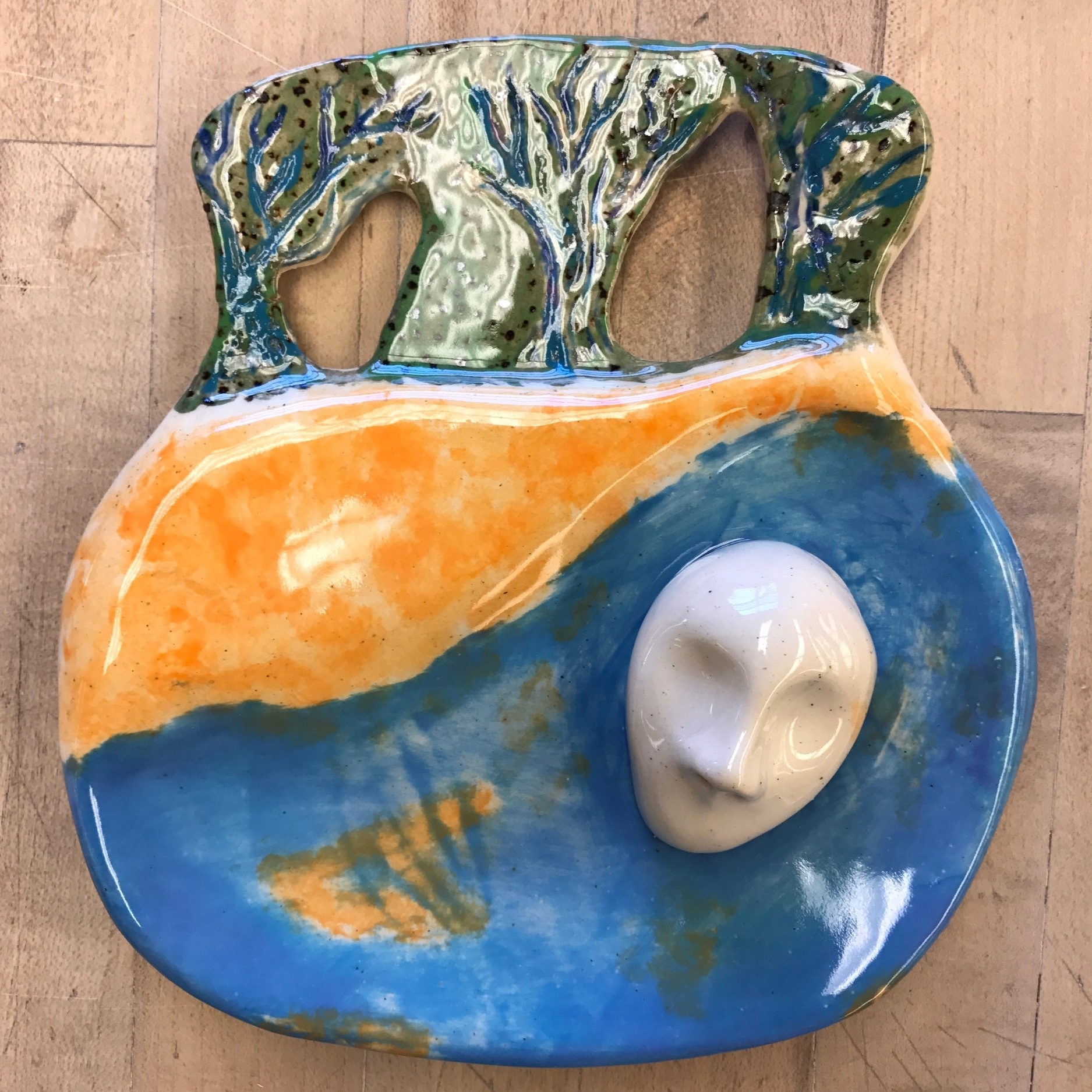
Slab Plates
Ceramic 2 student work that explores unique shapes in a simple slab form utilizing inlay and underglazing techniques to create narrative.
Earthenware, underglaze, clear glaze cone 6 oxidation
roughly 7" x 9"
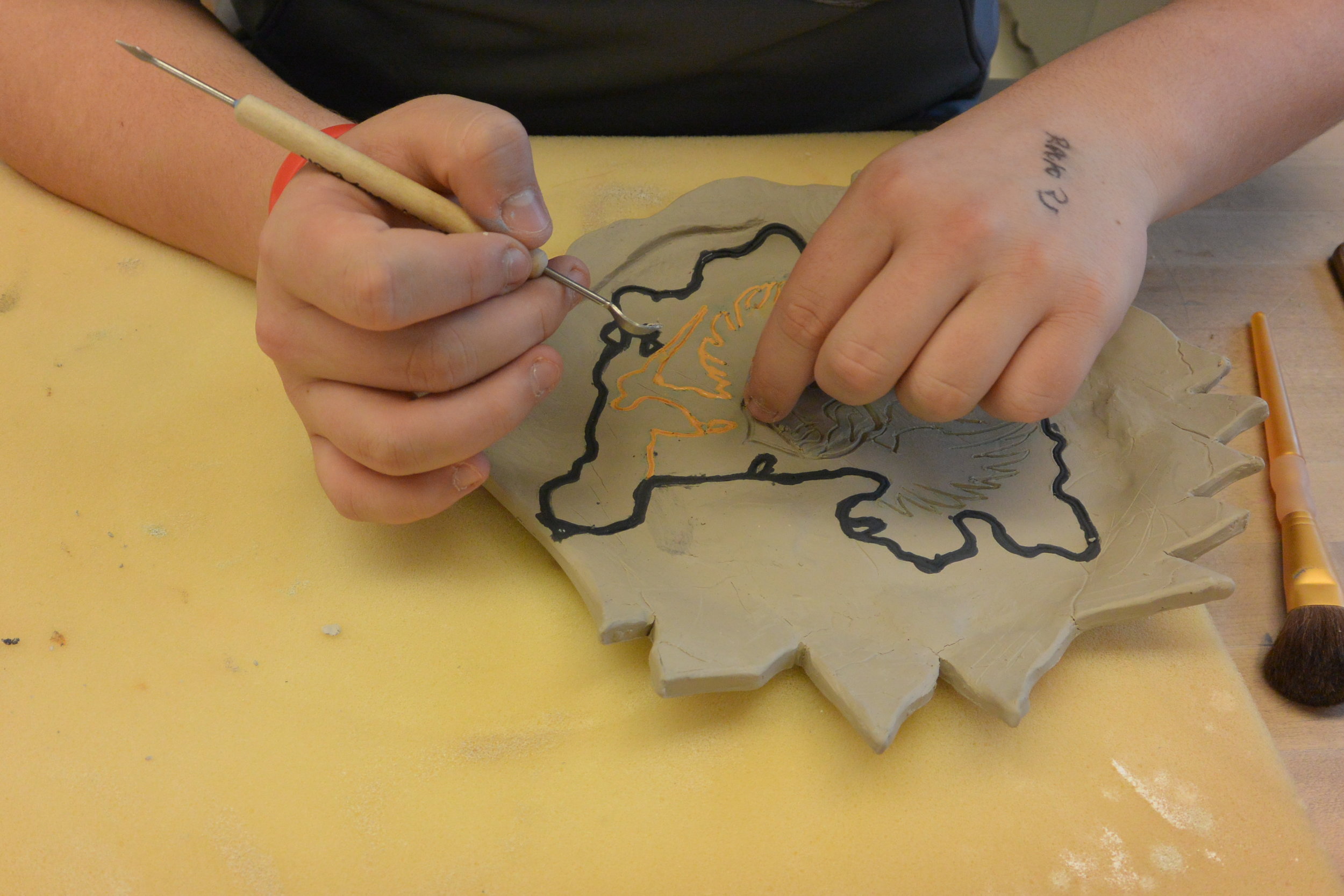
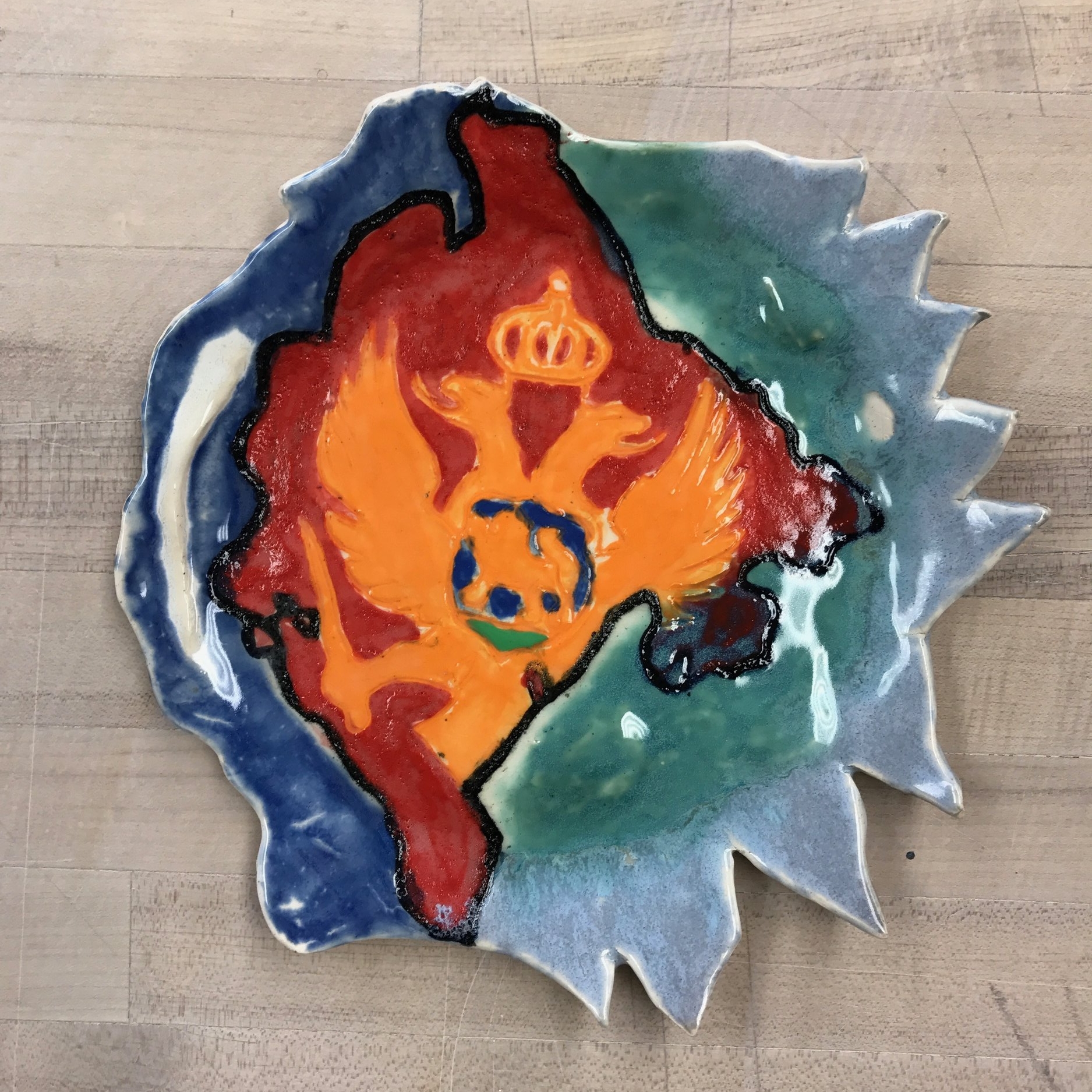
Slab Plates
Ceramic 2 student work that explores unique shapes in a simple slab form utilizing inlay and underglazing techniques to create narrative.
Earthenware, underglaze, clear glaze cone 6 oxidation
roughly 10" x 10"
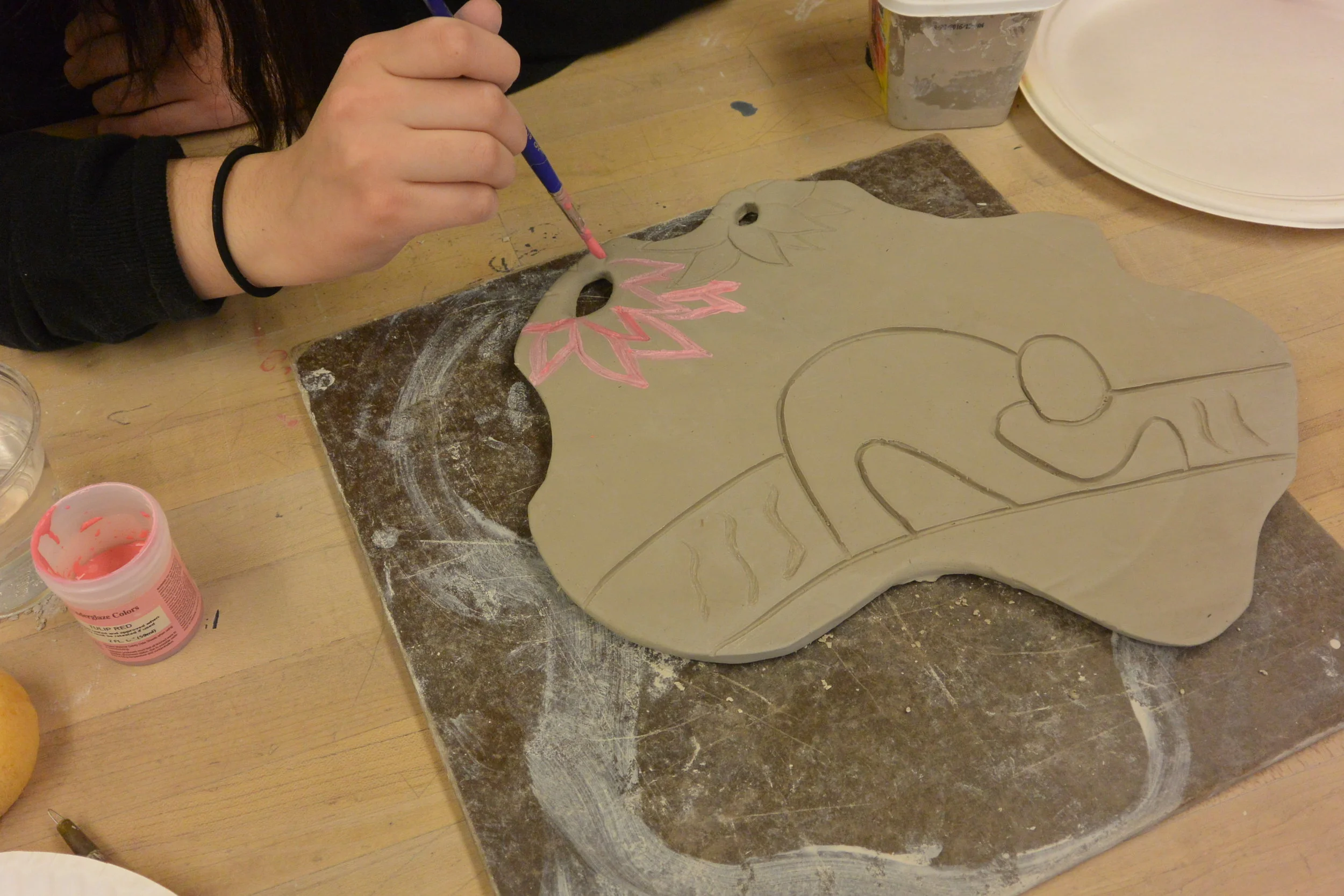
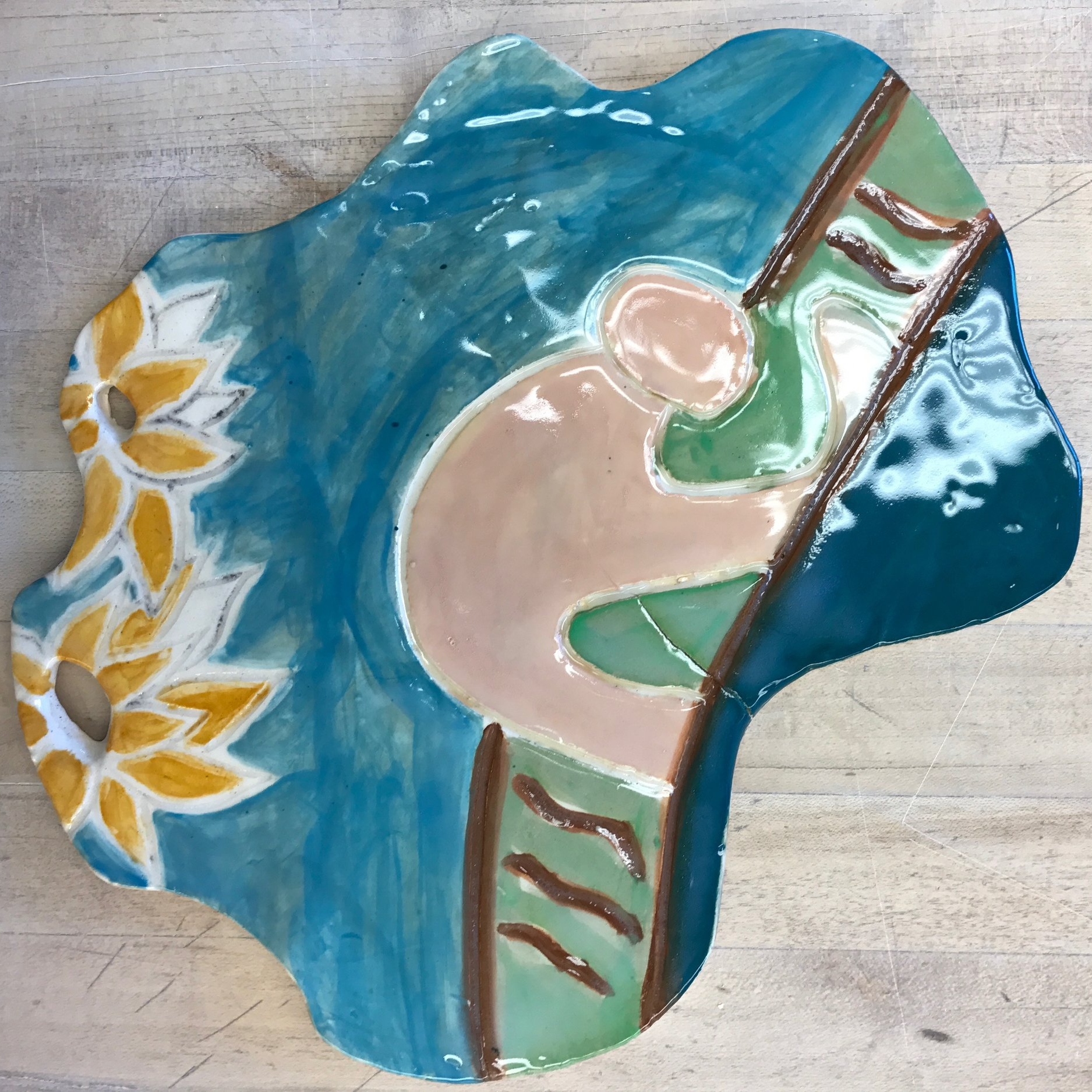
Slab Plates
Ceramic 2 student work that explores unique shapes in a simple slab form utilizing inlay and underglazing techniques to create narrative.
Earthenware, underglaze, clear glaze cone 6 oxidation
roughly 14" x 9"
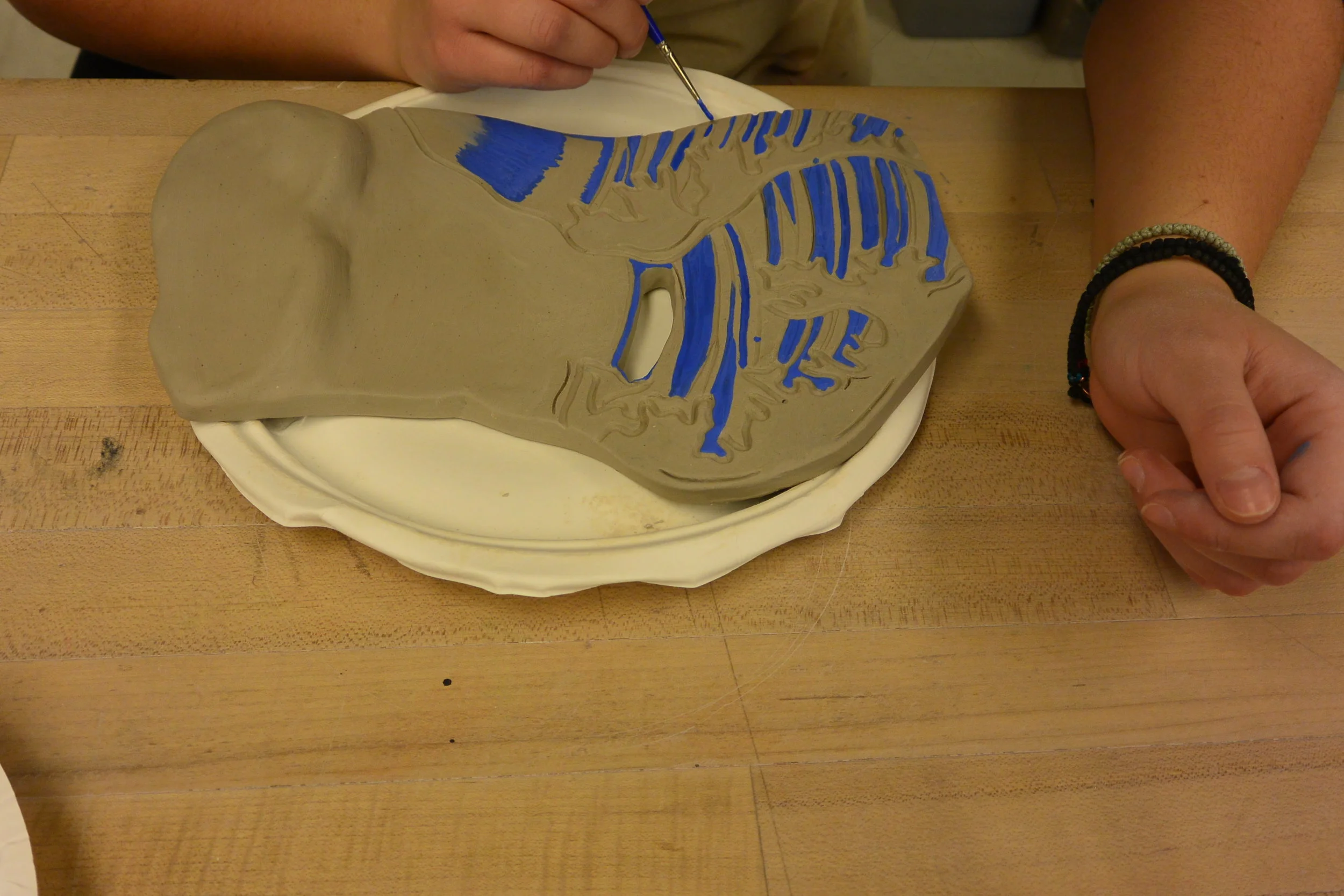
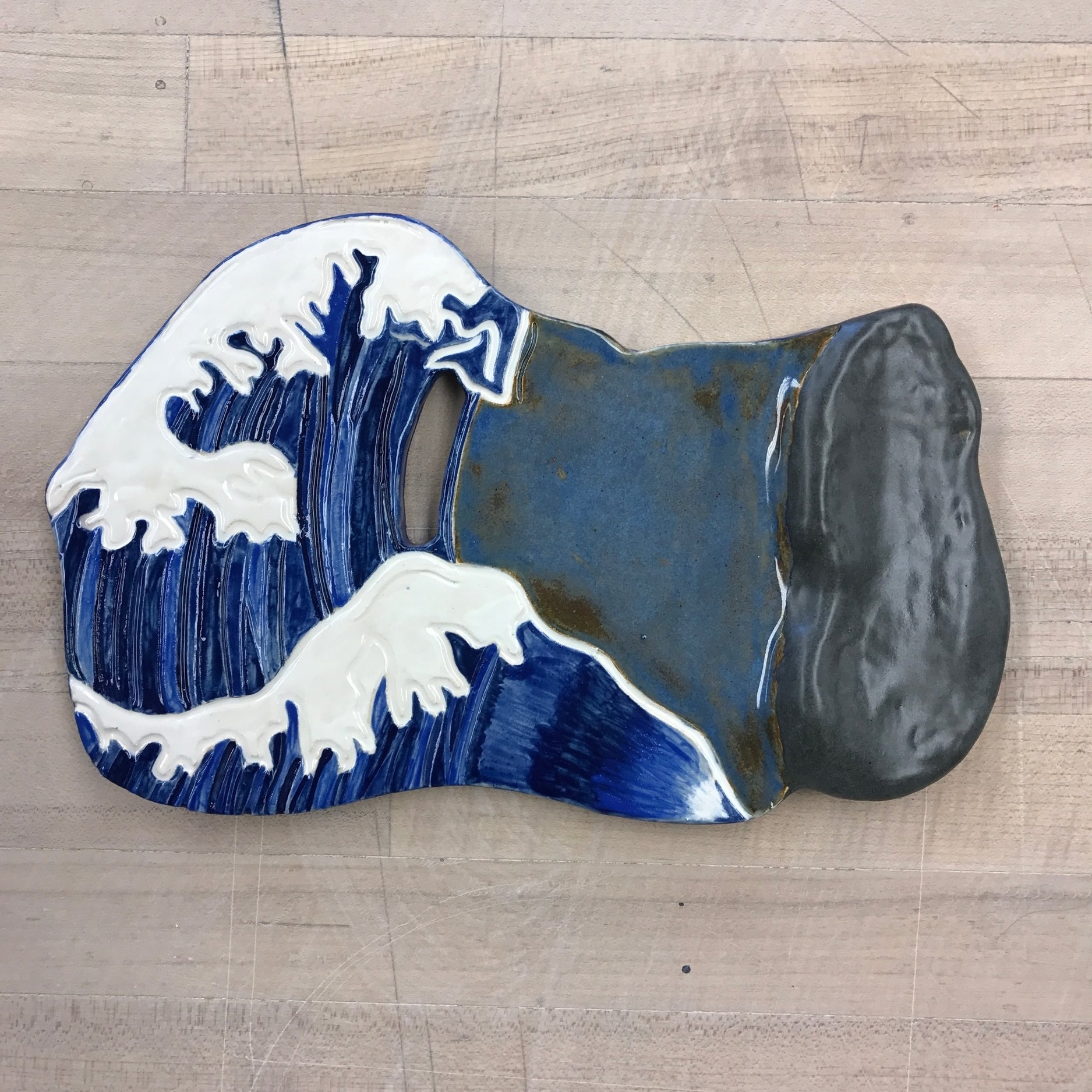
Slab Plates
Ceramic 2 student work that explores unique shapes in a simple slab form utilizing inlay and underglazing techniques to create narrative.
Earthenware, underglaze, clear glaze cone 6 oxidation
roughly 11" x 7"

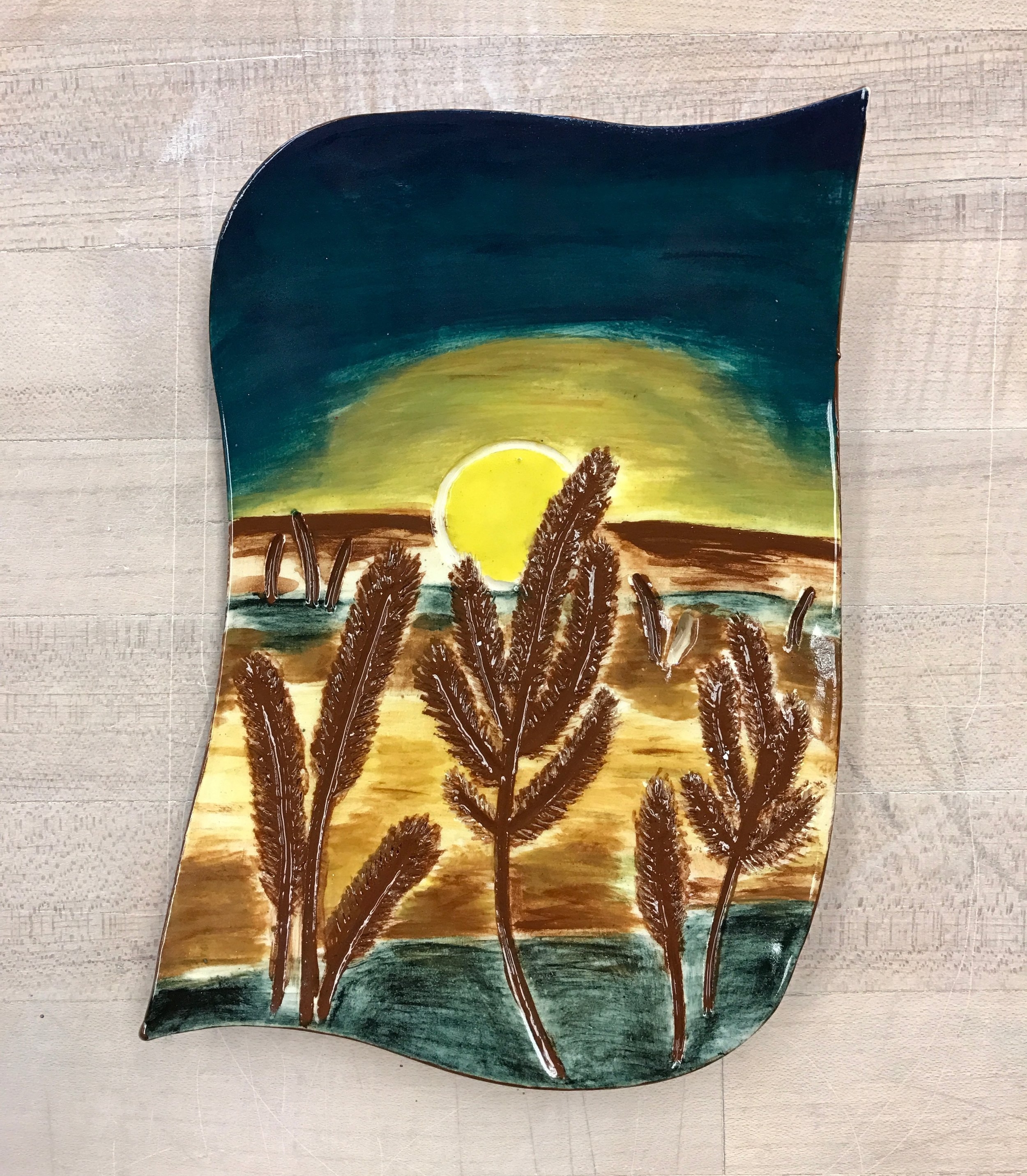
Slab Plates
Ceramic 2 student work that explores unique shapes in a simple slab form utilizing inlay and underglazing techniques to create narrative.
Earthenware, underglaze, clear glaze cone 6 oxidation
roughly 5" x 8"
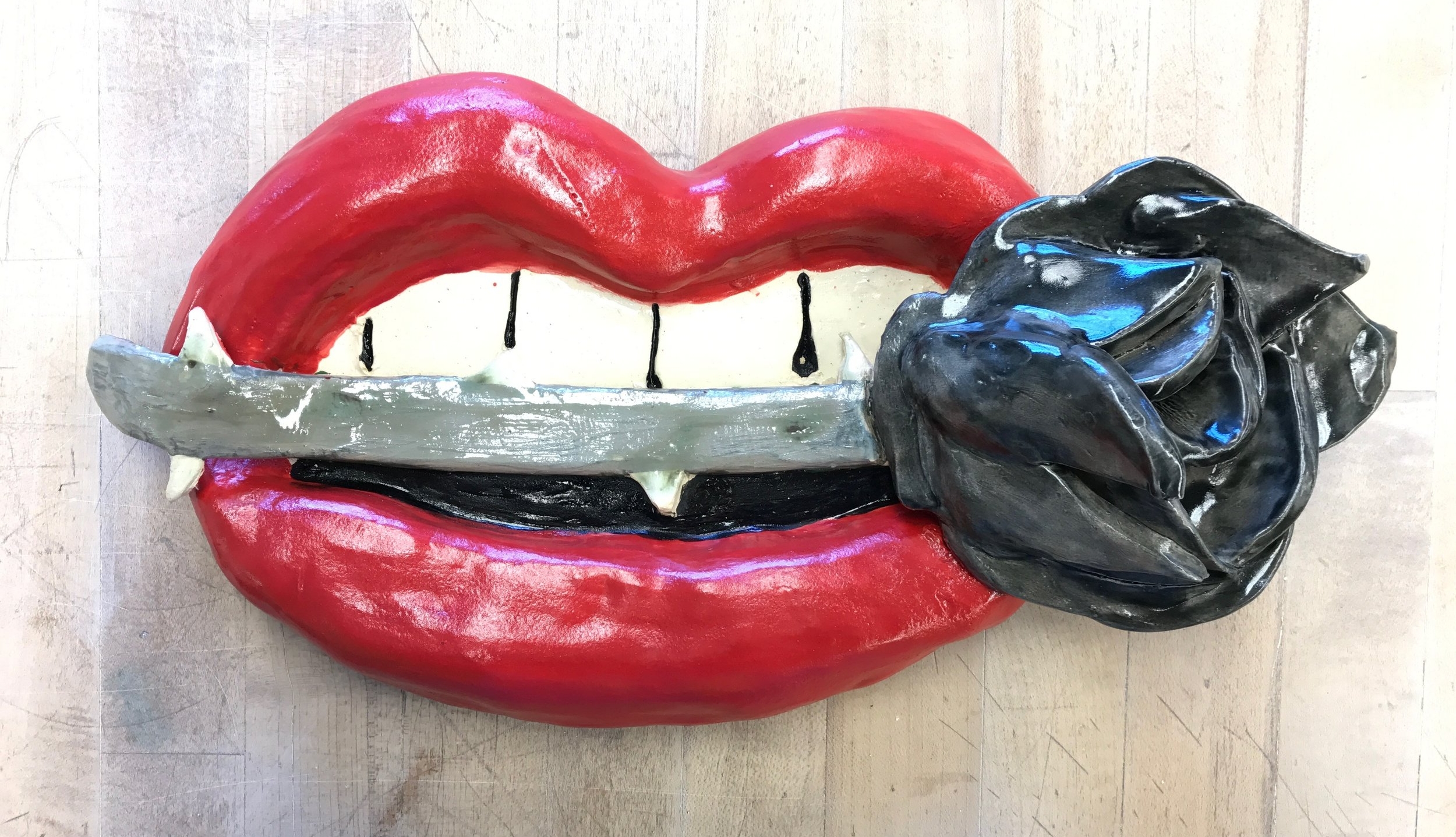
Slab Plates
Ceramic 2 student work that explores unique shapes in a simple slab form utilizing inlay and underglazing techniques to create narrative.
Earthenware, underglaze, clear glaze cone 6 oxidation
roughly 14" x 8"
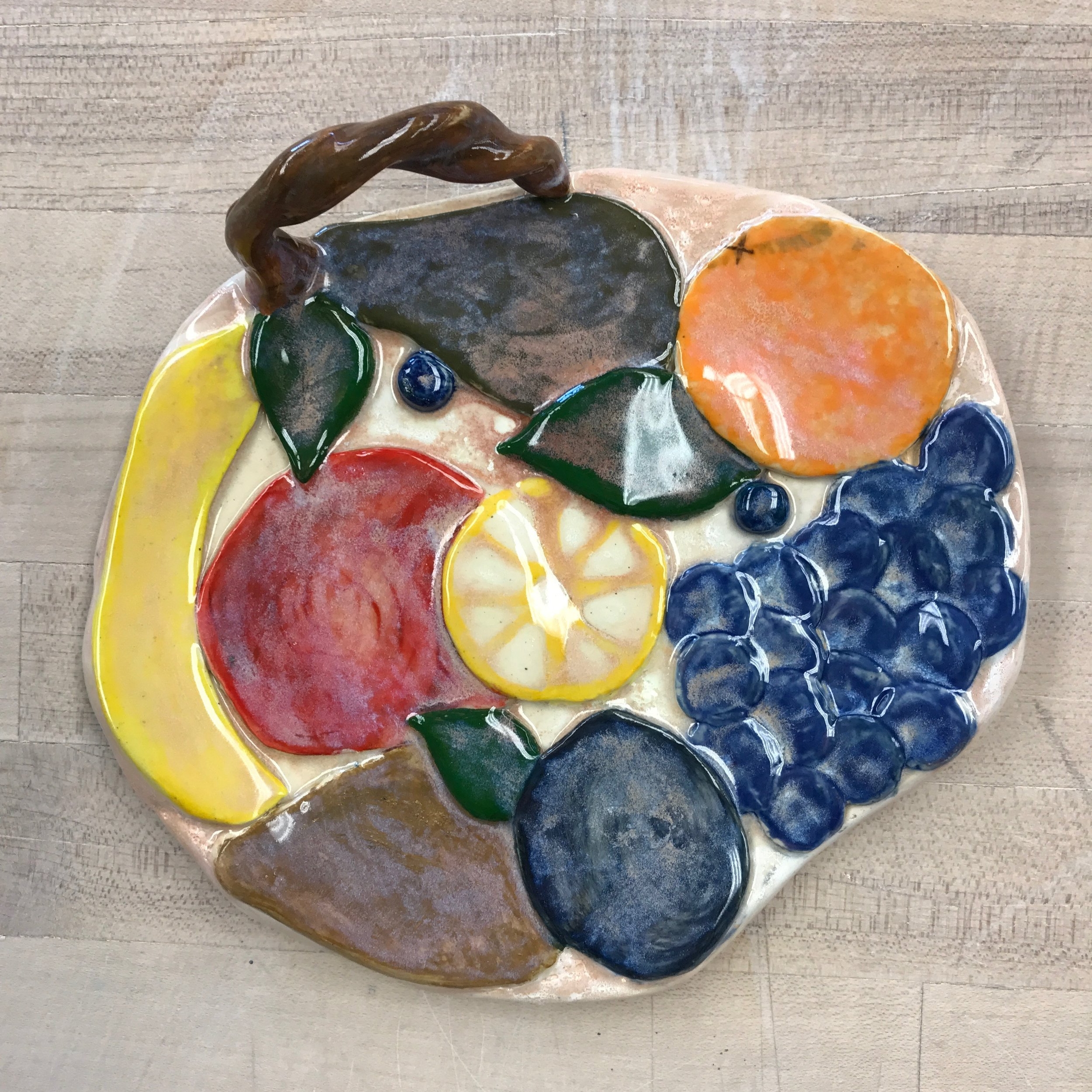
Slab Plates
Ceramic 2 student work that explores unique shapes in a simple slab form utilizing inlay and underglazing techniques to create narrative.
Earthenware, underglaze, clear glaze cone 6 oxidation
roughly 11" x 10"
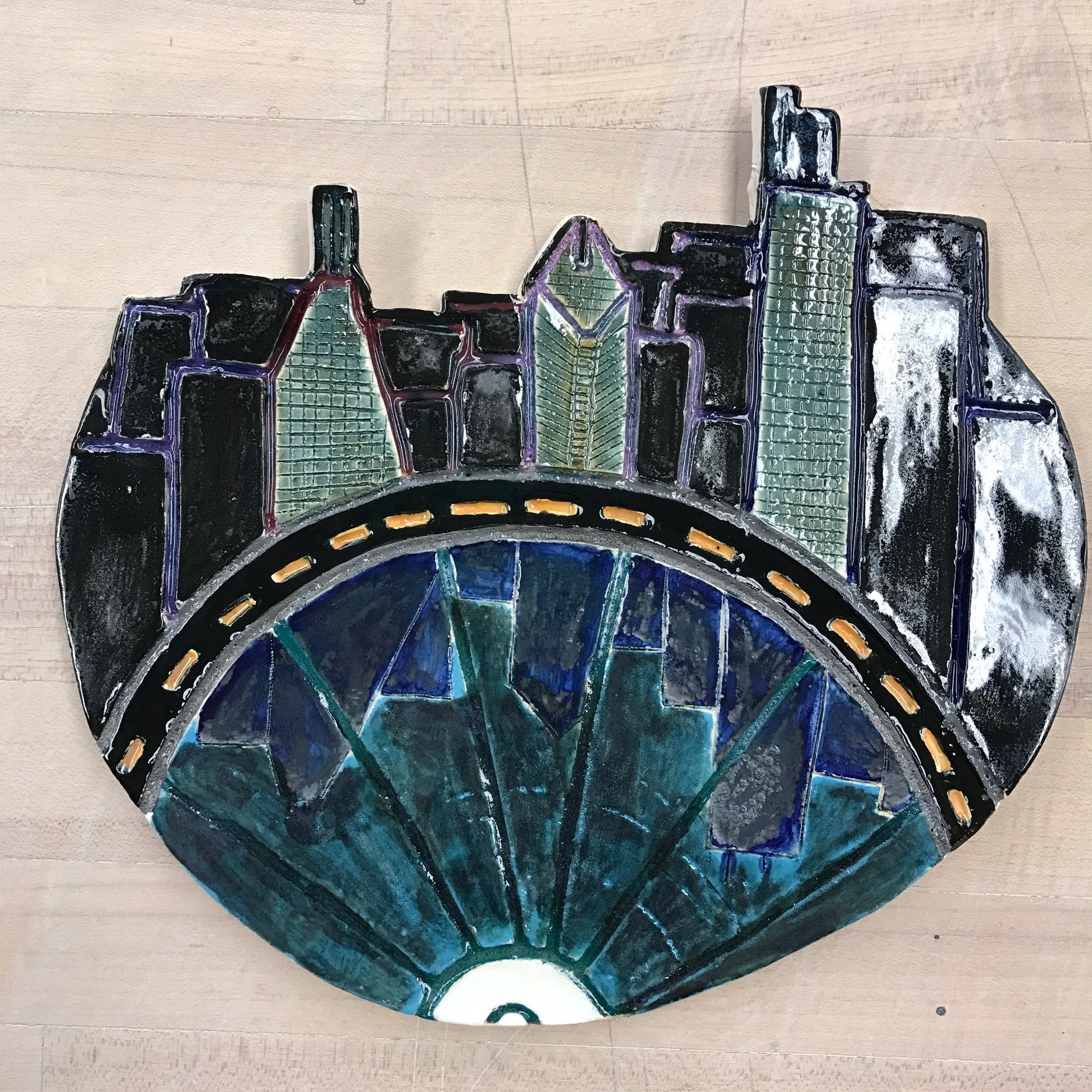
Slab Plates
Ceramic 2 student work that explores unique shapes in a simple slab form utilizing inlay and underglazing techniques to create narrative.
Earthenware, underglaze, clear glaze cone 6 oxidation
roughly 10" x 7"
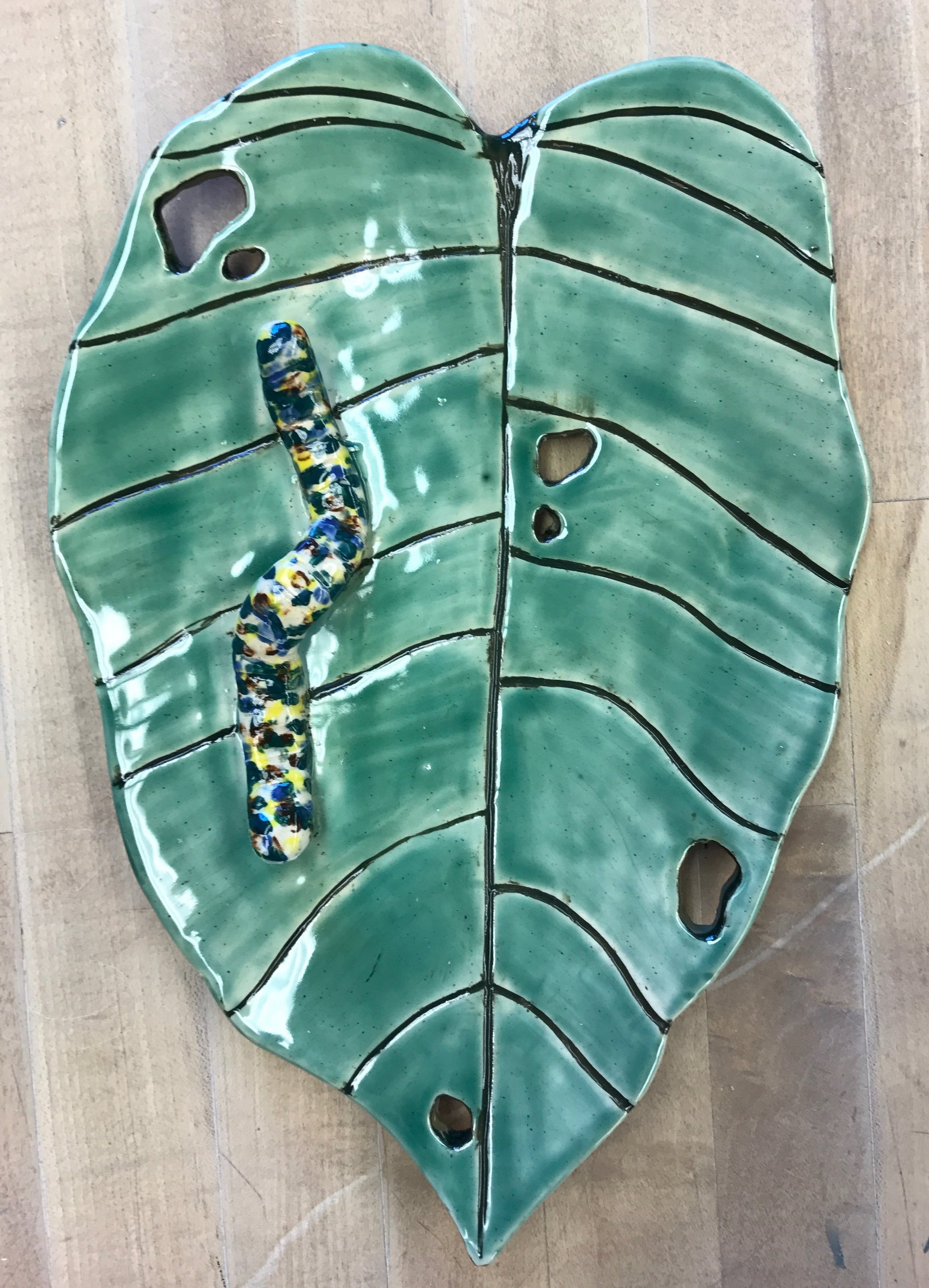
Slab Plates
Ceramic 2 student work that explores unique shapes in a simple slab form utilizing inlay and underglazing techniques to create narrative.
Earthenware, underglaze, clear glaze cone 6 oxidation
roughly 15" x 7"
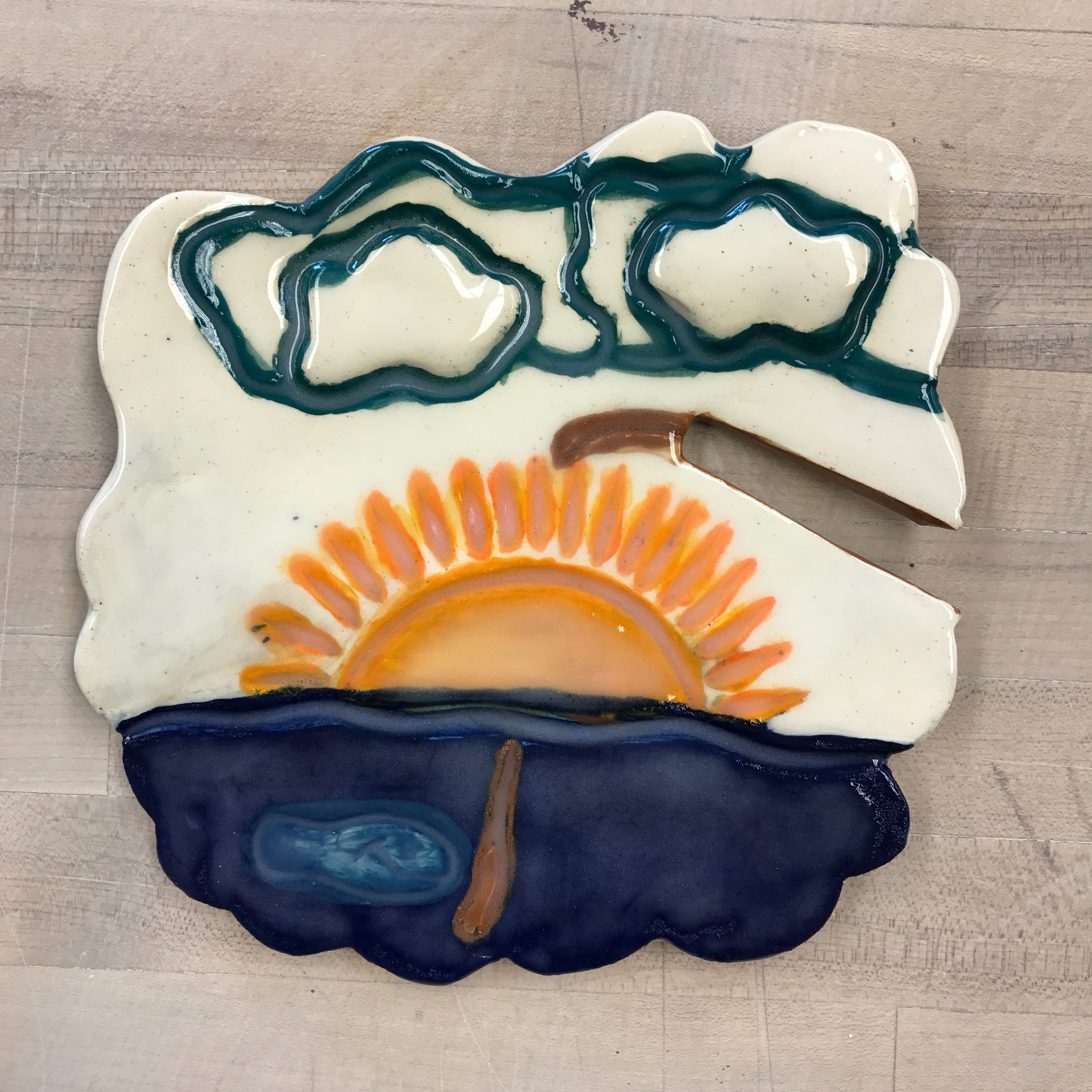
Slab Plates
Ceramic 2 student work that explores unique shapes in a simple slab form utilizing inlay and underglazing techniques to create narrative.
Earthenware, underglaze, clear glaze cone 6 oxidation
roughly 8" x 7"

Social Commentary Narrative Ceramics spread
Spread of Ceramic 2 artist inspiration and student processes of developing their own narrative ceramic vases that explored social issues through their own visual narrative commentaries.

Information board
While student teaching I developed this information board that featured everything to do with the project at hand - from objectives, to vocabulary, artist examples, and rubrics. This was displayed at the front of the room each day during my teaching.

Vase Blueprint worksheet
I developed this vase blueprint support to help students develop and refine their ideas before they moved on to decorating their final vase forms.

Teacher exemplars
My examples of the greenware piece similar to what students make, as well as a completed vase blueprint support to help develop and refine ideas before decorating the final vase forms.
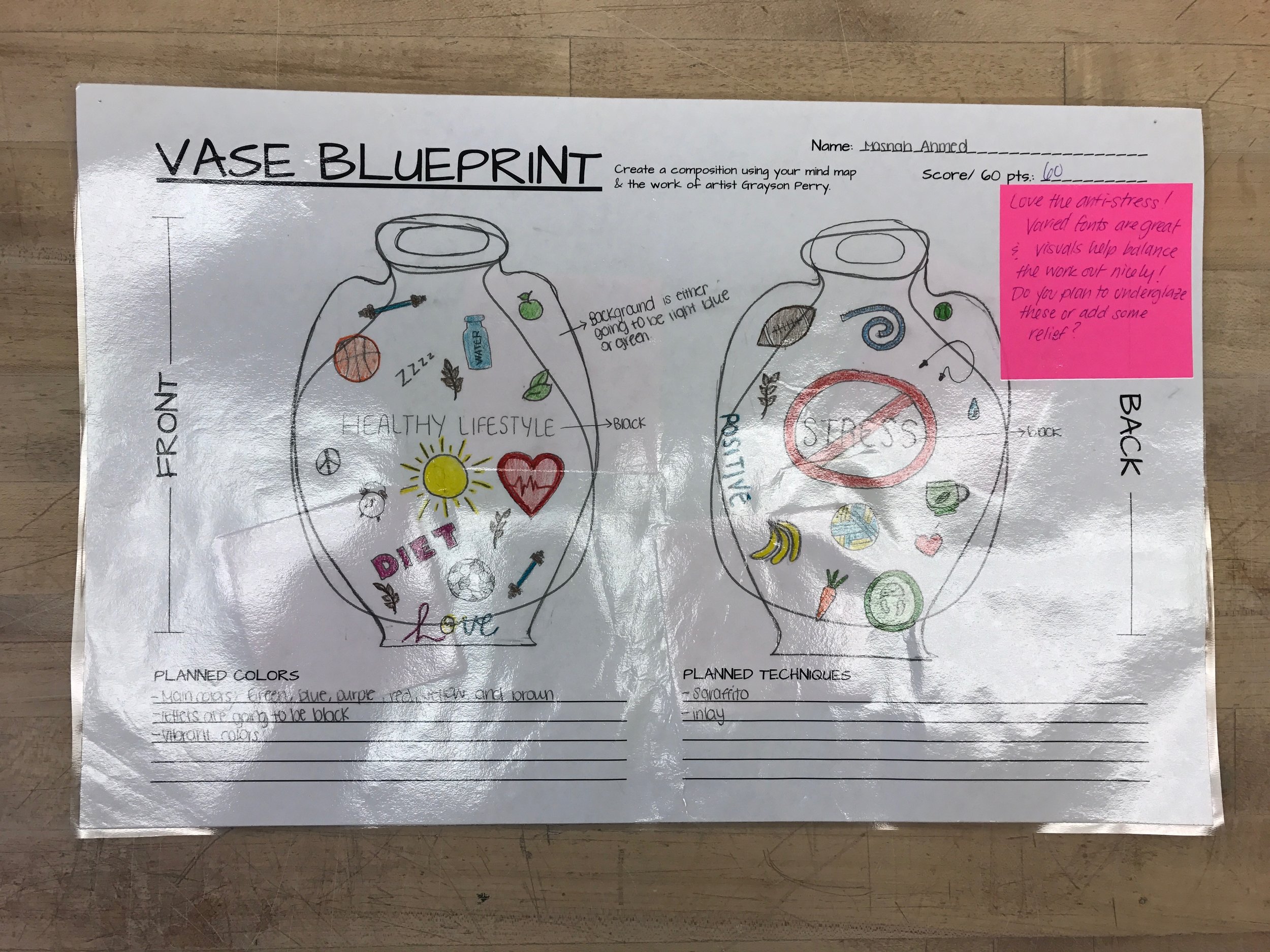
Student work
Completed vase blueprint worksheet with written teacher feedback with suggestions on how to move forward.

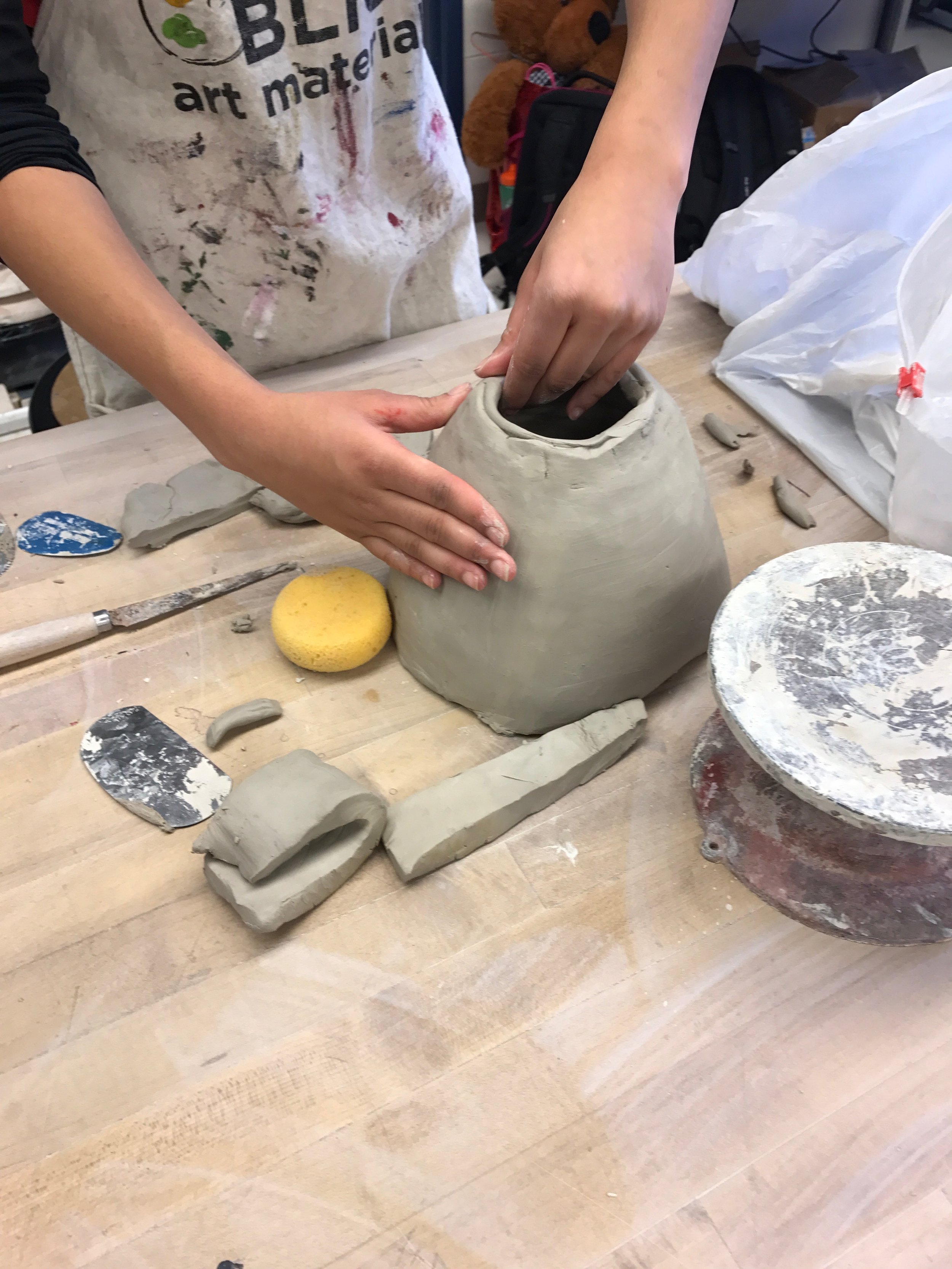


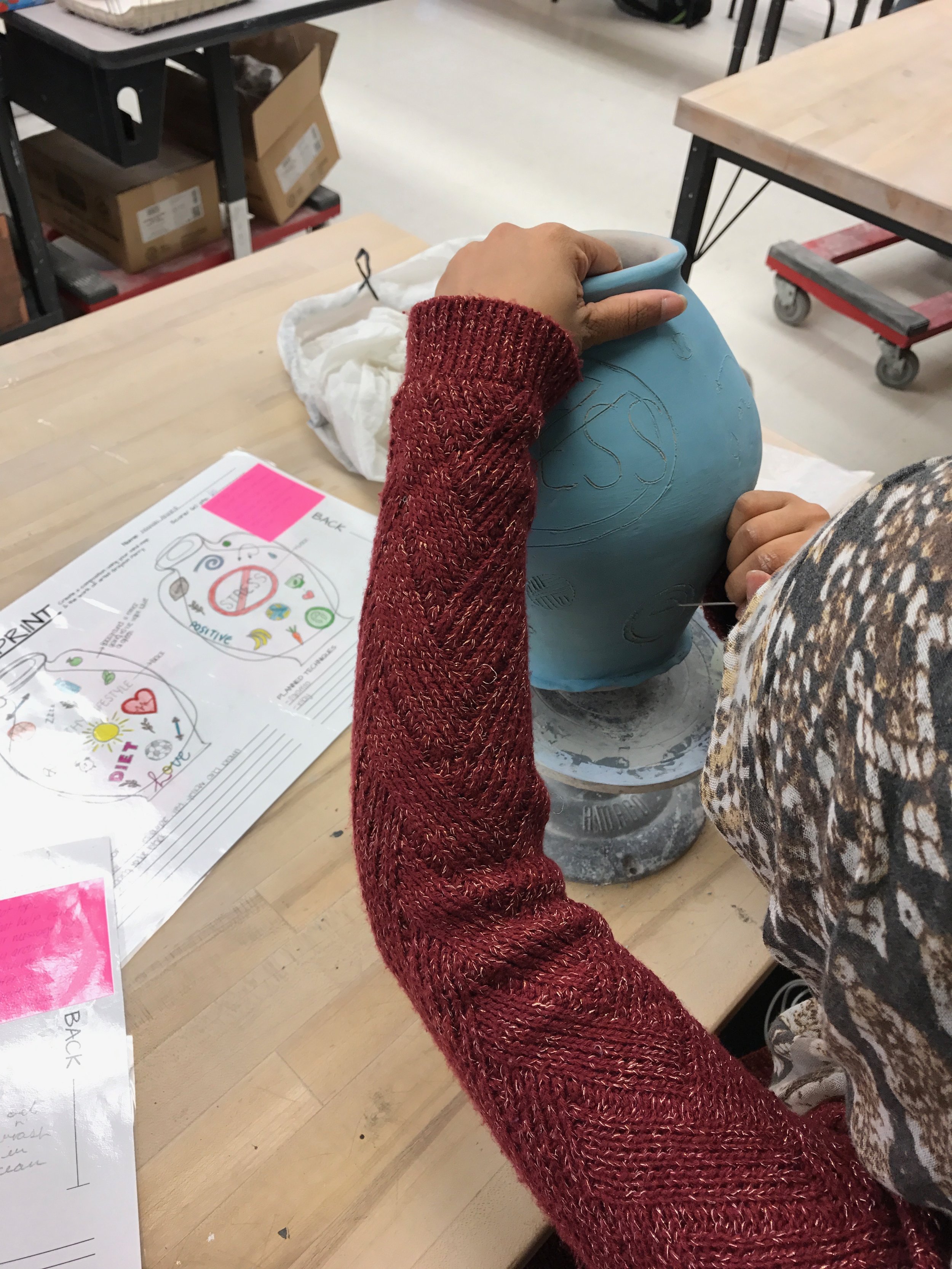










Peer Sticky Note Critique
Students participated in a peer sticky note critique once they completed work on their vase blueprints. This acted as a way for students to see each other's work, as well as discuss audience and what the intended meaning students wished their work to be perceived as.

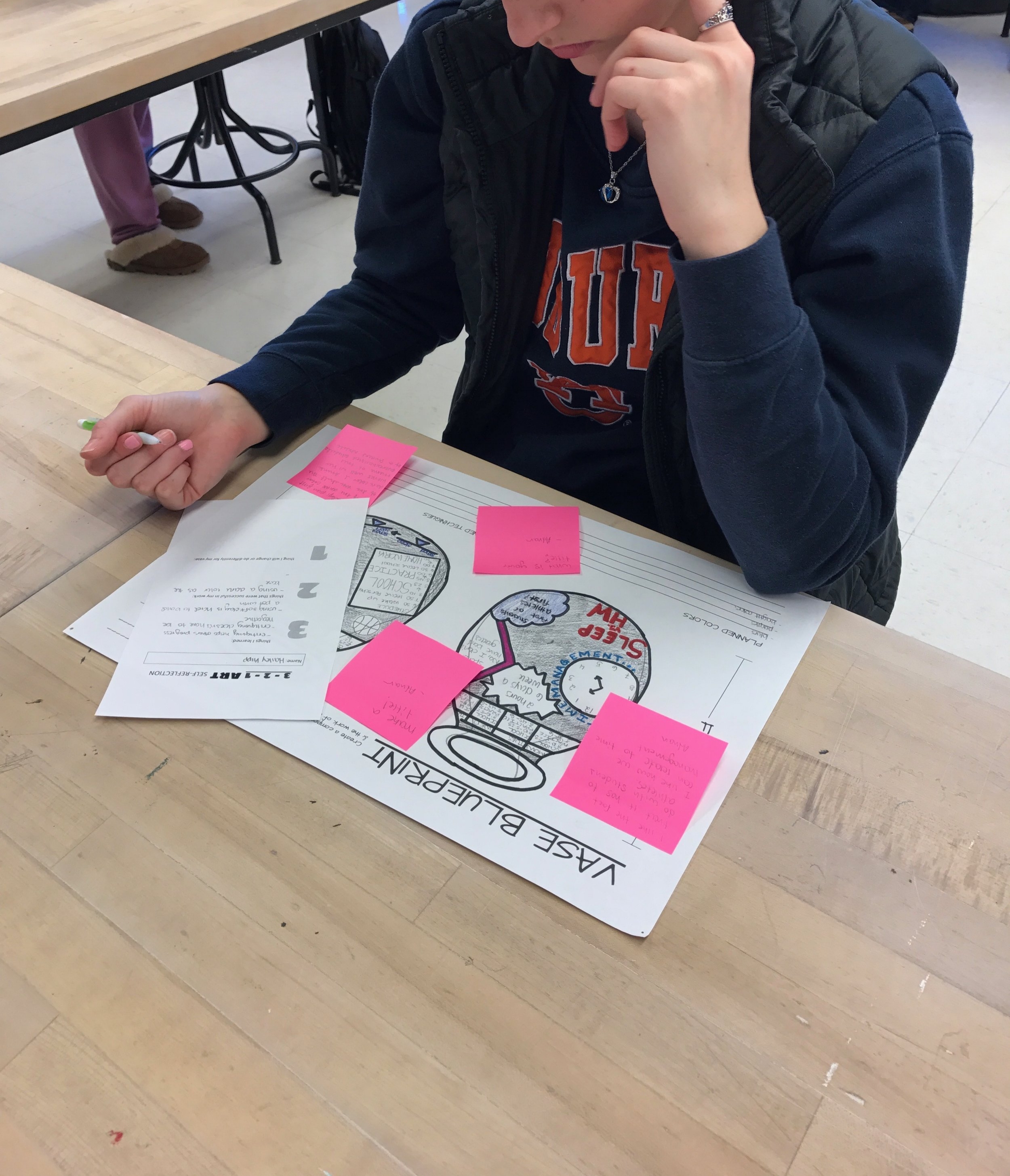
Student reading their feedback while completing a self reflection of their vase blueprint.
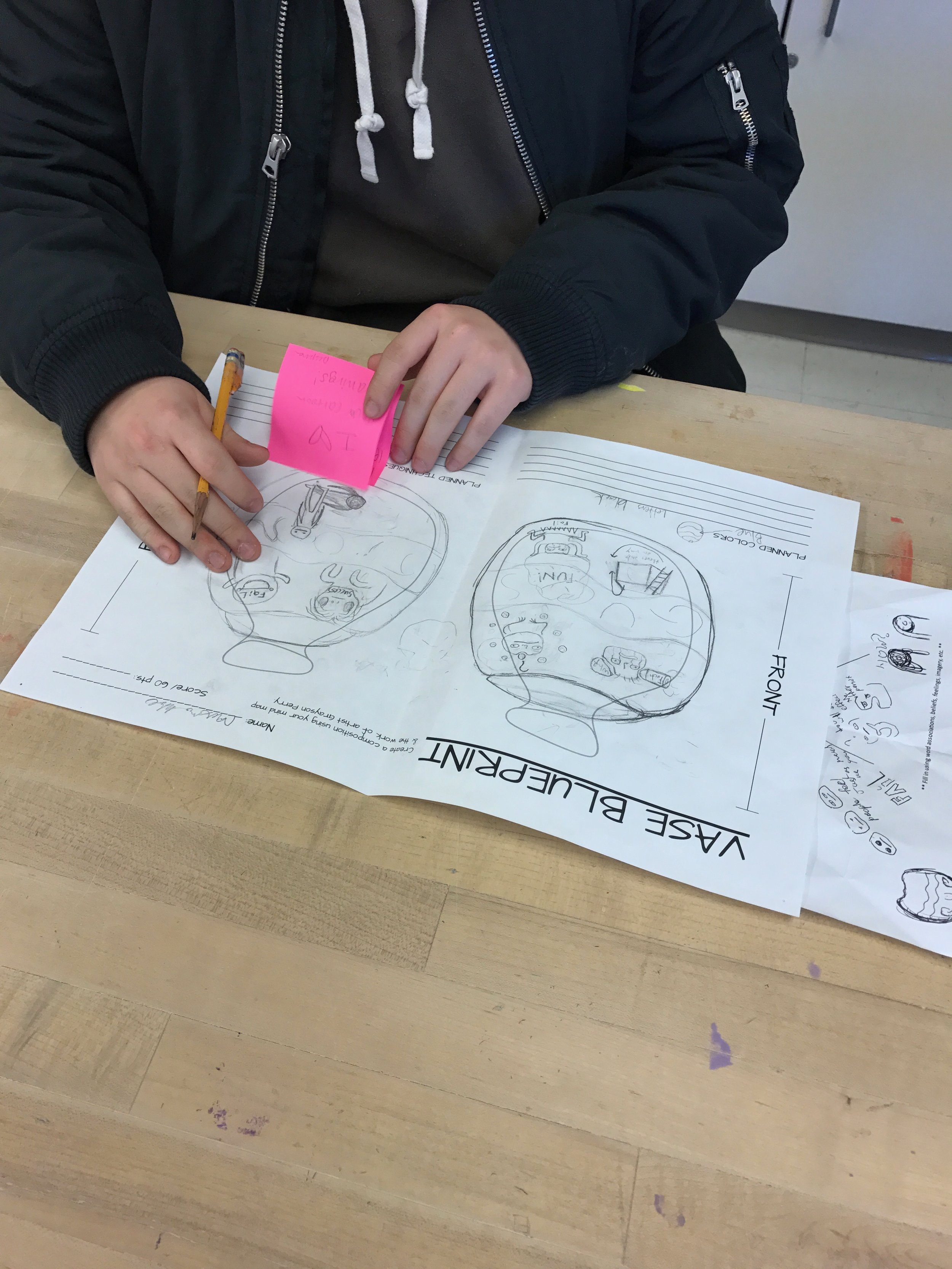
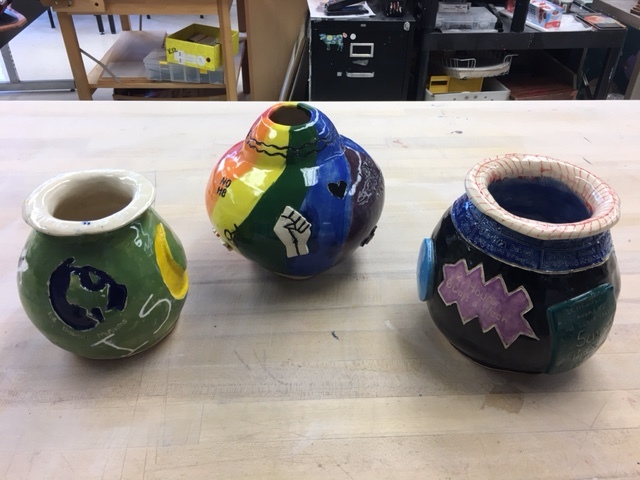
Completed student vase forms
Students explored social issues ranging from Islamophobia (left), LGBTQ rights (center) and being a student-athlete (right)
These forms provided a canvas to discuss their various commentaries on social issues. These social commentaries were then supported and broadcasted on social media through the application Instagram. This aspect of the lesson is explored deeper under my Graduate Thesis section of this website.
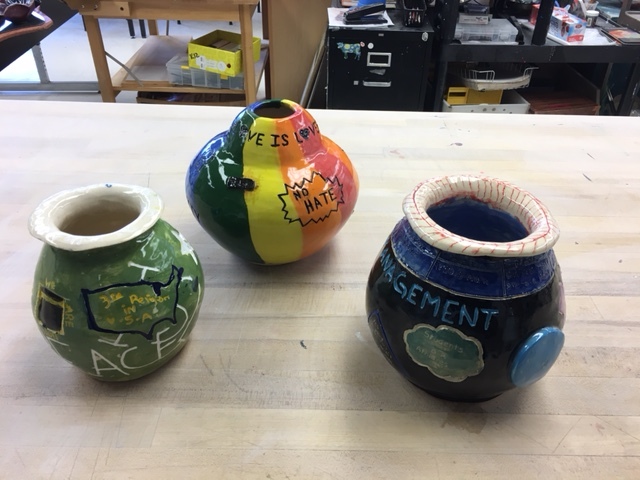
Reverse side of completed vase forms
Students explored social issues ranging from Islamophobia (left), LGBTQ rights (center) and being a student-athlete (right)
These forms provided a canvas to discuss their various commentaries on social issues. These social commentaries were then supported and broadcasted on social media through the application Instagram. This aspect of the lesson is explored deeper under my Graduate Thesis section of this website.
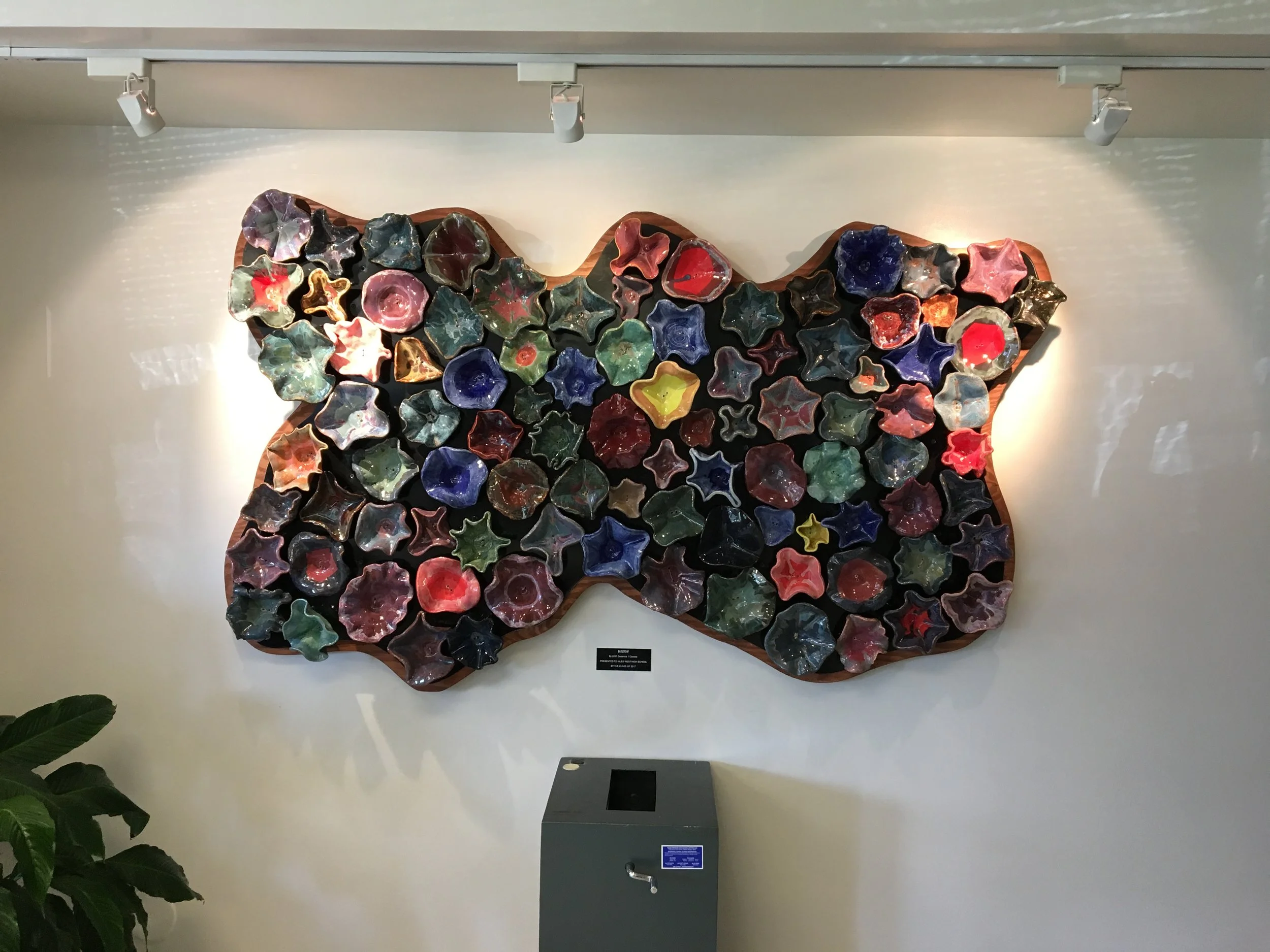
Dale Chihuly Inspired Installation
Ceramics I students worked independently to create several organic shaped slab slumped bowls which were then glazed in bright colors reminiscent of Dale Chihuly's magnificent blown glass sculptures. Working collaboratively the bowls were then assembled into one large sculpture.
The school was so impressed with the students' work that the senior class decided to purchase the piece and permanently install it in the office!

Bowls laid out before installation onto support backing.

Bowls laid out before installation onto support backing.

Exemplar of Personal Visions
High school students were introduced to the work of outsider artist Howard Finster and his portraiture. They created and composed their own personal vision self portraits in this style. Their work began with text, where students wrote a short narrative of where they see themselves in the near future. By composing imagery aligned with their text, they visualized their personal message to others using acrylic paint on paper.
This is my exemplar.

Personal Visions
Students created and composed their own personal vision self portraits in the style of Howard Finster. Their work began with text, where students wrote a short narrative of where they see themselves in the near future. By composing imagery aligned with their text, they visualized their personal message to others using acrylic paint on paper.

Personal Visions
Students created and composed their own personal vision self portraits in the style of Howard Finster. Their work began with text, where students wrote a short narrative of where they see themselves in the near future. By composing imagery aligned with their text, they visualized their personal message to others using acrylic paint on paper.
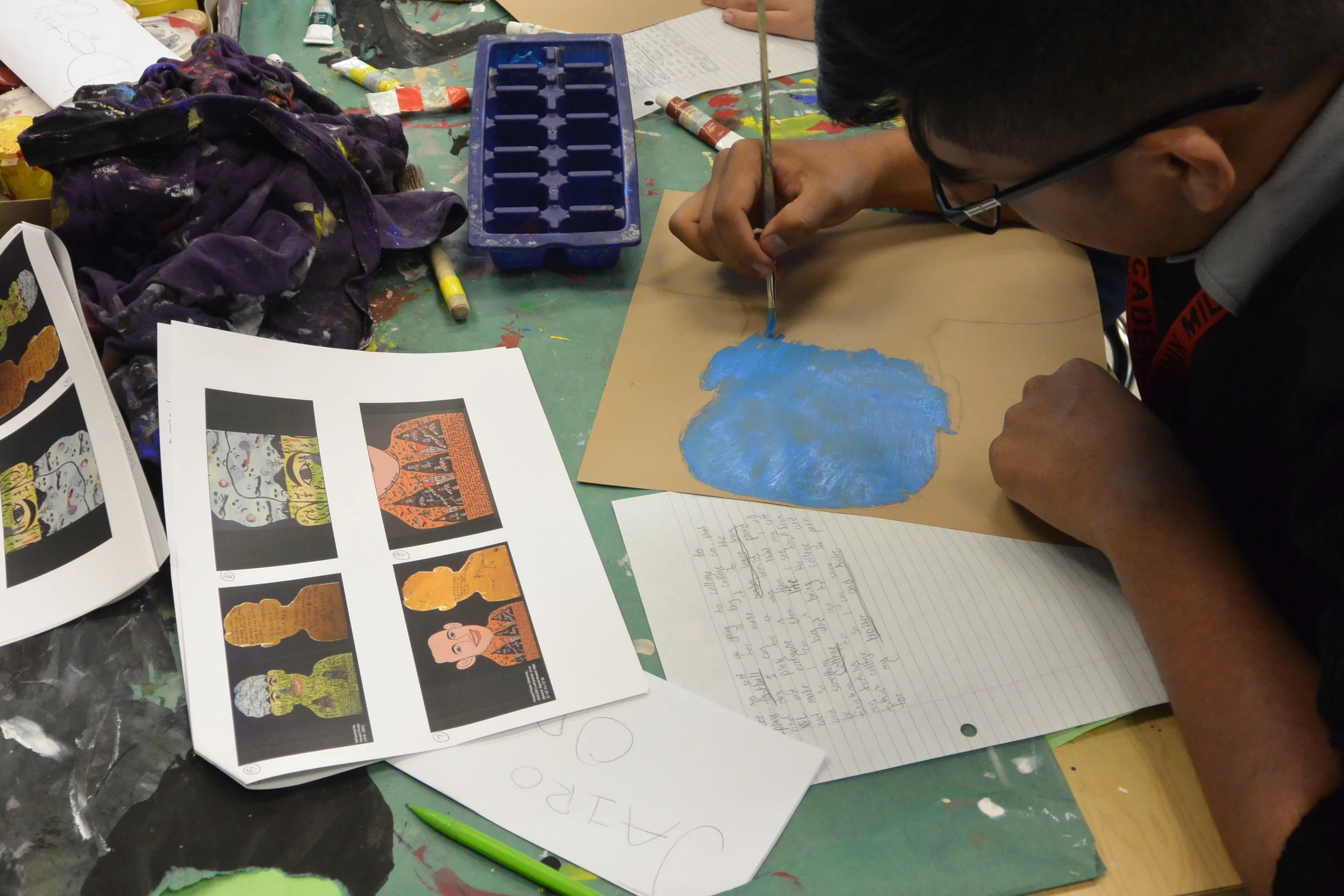
Personal Visions
Student working on their portrait in the style of Howard Finster. I presented a slide show of several examples of work, asking students to describe each piece. We talked through his personal artistic history before embarking their our own projects.
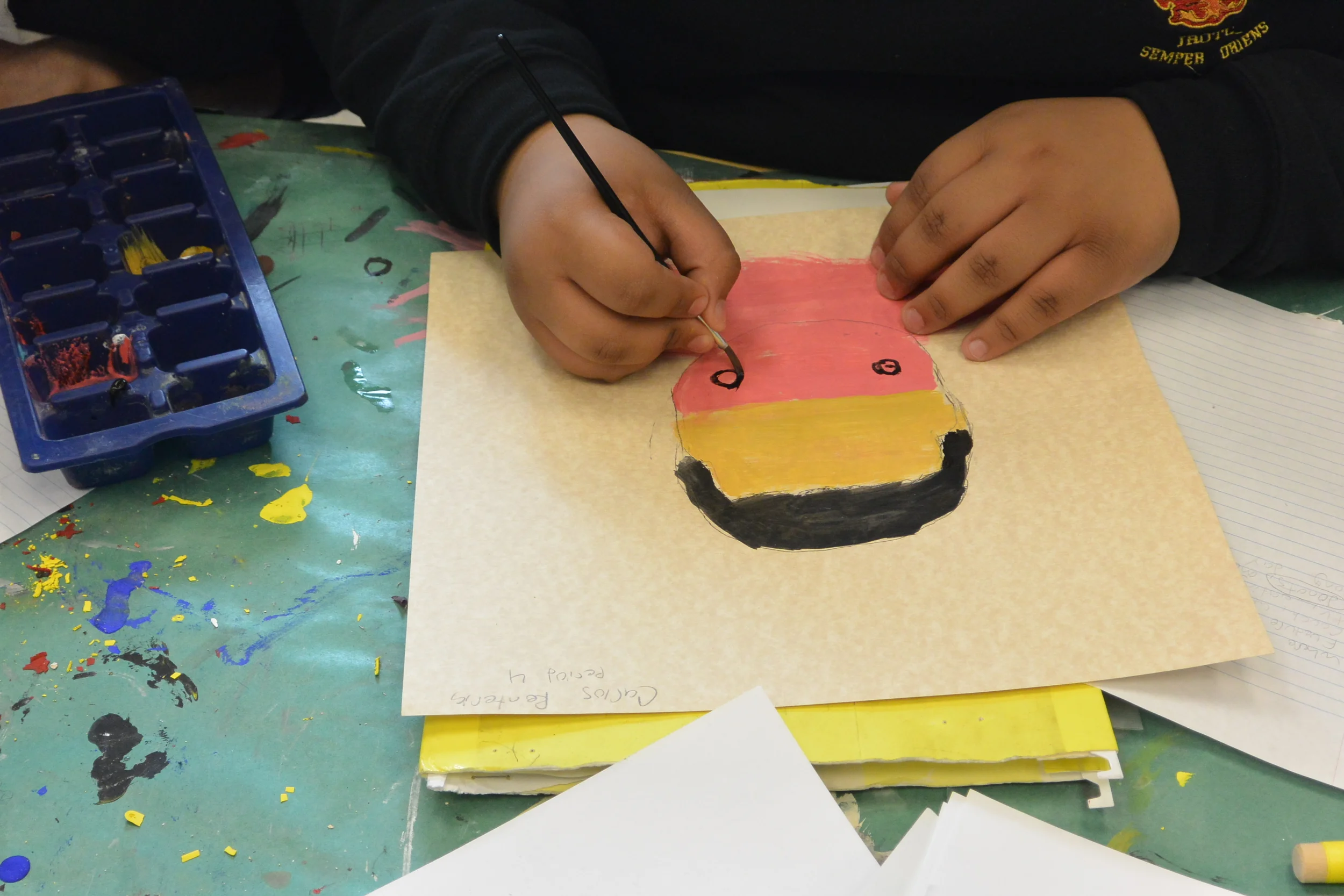
Student working on their Personal Vision portrait

Student working on their Personal Vision portrait

Student example of their Personal Vision portrait


































































































